SUNDAY
FEBRUARY 15 - 2015
Malcolm's
news
It was a very
pleasant almost spring-like morning for a stroll
through Brook Meadow and round Slipper Millpond. While
on Brook Meadow we met Malcolm Phillips who had just
seen and photographed a Treecreeper near the south
bridge, his first one of the year.
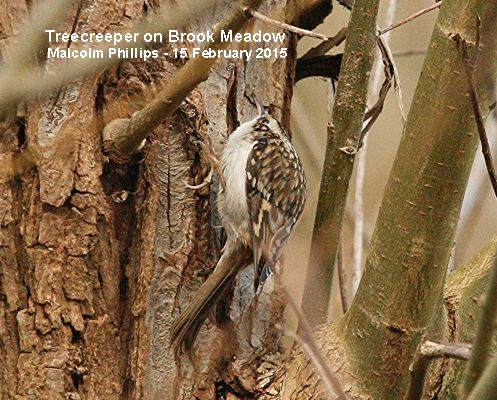
Malcolm also got a
shot of a Blue Tit with nest materials in its bill
emerging from what must be a nesting hole in one of
the large Crack Willows on the north path.
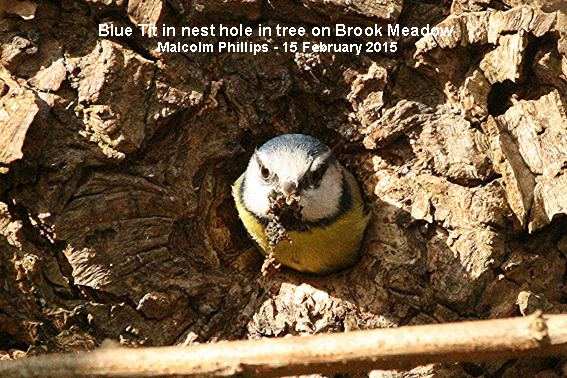
Malcolm said he had
not seen the Siberian Chiffchaff for some weeks (since
Jan 14 in fact) and thought it must have gone. He had
not seen any common Chiffchaffs either. The long
staying Water Rail has also not been seen since Jan 31
and may have moved on as well.
Plant
news
While on Brook
Meadow I checked the flower spikes of Butterbur
which are now starting to emerge from the buds in the
area below the main seat.
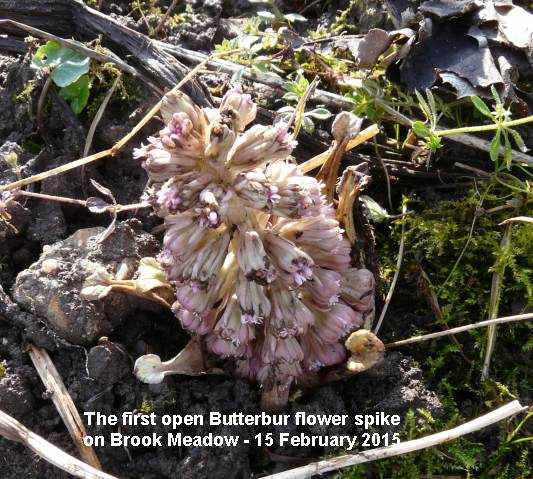
Along the path behind
Lillywhite's Garage I found a variety of plants in
flower including Sweet Violet, Common Field Speedwell,
Common Chickweed and a bright yellow flower of
Lesser Celandine.
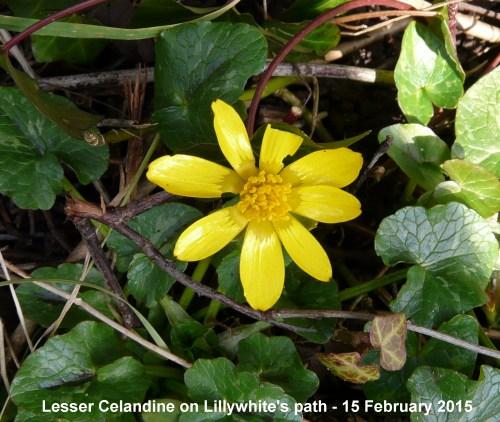
Also along this path
there a fresh growth of Lords and Ladies,
including some with dark spotted leaves.
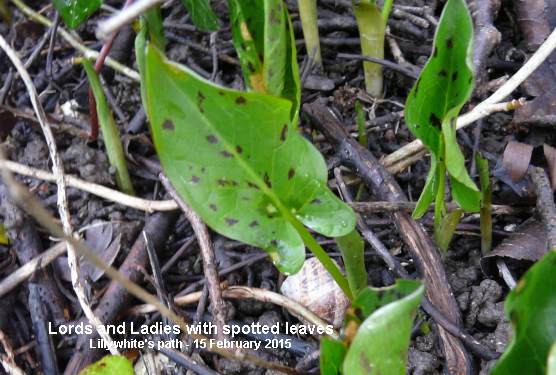
The now severely
truncated Gorse bush on the east side of
Slipper Millpond is flowering well and looks good on
this photo with the pool in the background.
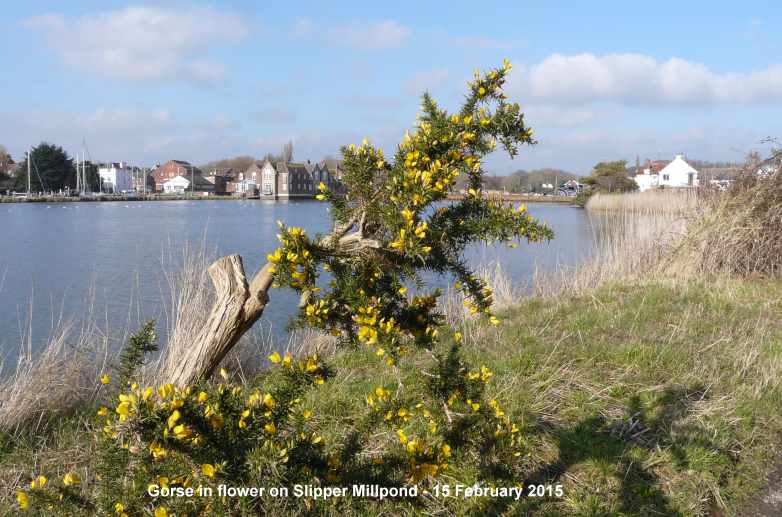
Looking more closely
at its rich golden yellow flowers one can appreciate
why the plant botanically belongs to the pea group.
The flowers have the characteristic five petals of the
pea family with a standard petal at the top, two wing
petals at the sides and two lower petals forming a
boat-shaped keel.
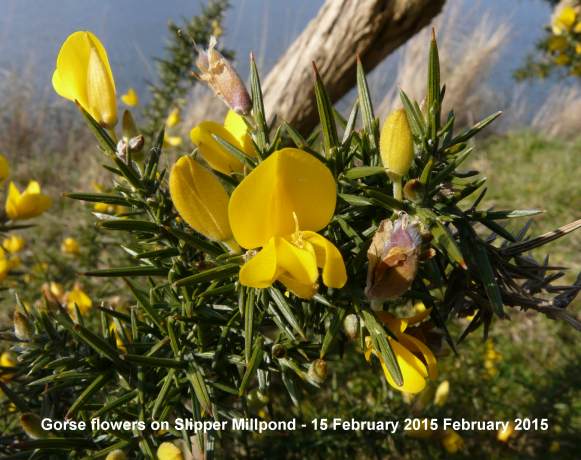
Tagged
Greenshank
Glynis and Tim
Irons had a lovely walk this morning with their 9-year
old son Thomas through Brook Meadow, Peter Pond, the
Harbour and then to the town millpond. Thomas, who is
a keen birdwatcher, spotted wading birds in the
harbour and took some photos. One of them was a
colour-ringed and tagged Greenshank - RG+BY tag
(ie left leg: red over green and right leg blue
over yellow with the geo tag on the blue ring).
Although Thomas's photo only shows the left leg rings
he also saw the colours on the other leg which enabled
me to identify it.
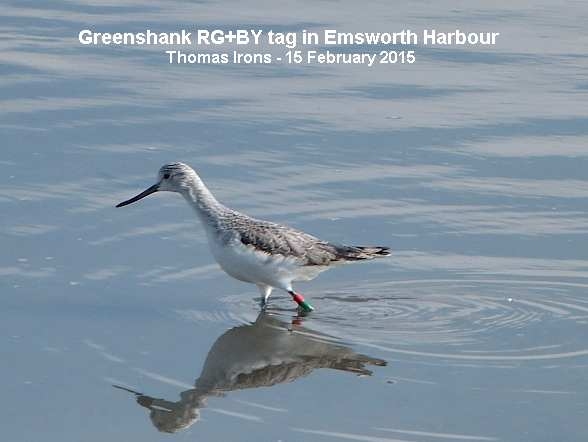
RG+BY tag was one of 3
Greenshanks that Pete Potts and his team caught at
Thorney on 19-Mar-13 and fitted geolocators to the
blue rings. The bird has been seen 10 times in
Emsworth Harbour since its ringing and today's
sighting was the 5th in this winter season.
First
Blackbird song
As I was
writing this blog at 6pm this evening my wife called
me into the kitchen to hear a bird singing in the back
garden. It was our first Blackbird song of the year
and the song was full and rich, certainly not a
sub-song in any way. Last year I heard my first
Blackbird song on Feb 16th so it looks as if it is
about on time.
Hybrid
goose on Baffins Pond
Eric Eddles
helped to answer my puzzlement over why the hybrid
goose on Baffins Pond that he photographed on Feb 13
should be so different in appearance from one of its
assumed parents ie a Canada Goose. Eric said that
expert Dave Appleton wrote as follows: 'It is likely
to be a hybrid between a domestic goose such as
(Embden) and a Canada Goose. Such very white birds as
this are difficult to separate from domestic geese as
the white plumage masks the usual signs of Canada
Goose involvement, so I would shy from being 100%
positive, but it is as least consistent with how I
would expect a domestic goose x Canada Goose hybrid to
appear.'
Thanks, Eric. I think that resolves my problem with
the ID, though I still think it is a bit strange that
things happen this way.
Finally, Peter
Milinets-Raby sends a link to breeding event between a
domestic goose and a lame female Canada Goose which he
says sheds some light on things and resolves the
situation. As Peter says, the offspring in the photos
that are white look just like the Baffins Pond bird.
See . . . http://www.backyardchickens.com/t/645769/just-for-fun-hybrid-geese
Havant
Wildlife Group at Southsea
Fay Durant
reported on yesterday's walk by the Havant Wildlife
Group:
See . . . http://familyfellows.com/hwg-walk-reports-2015.htm
SATURDAY
FEBRUARY 14 - 2015
Hybrid
Goose on Baffins Pond
Peter
Milinets-Raby said he had a 20 minute break at Baffins
Pond yesterday and found himself looking at the
'hybrid goose' photographed by Eric Eddles - see blog
for Feb 13. Here is Eric's original photo.
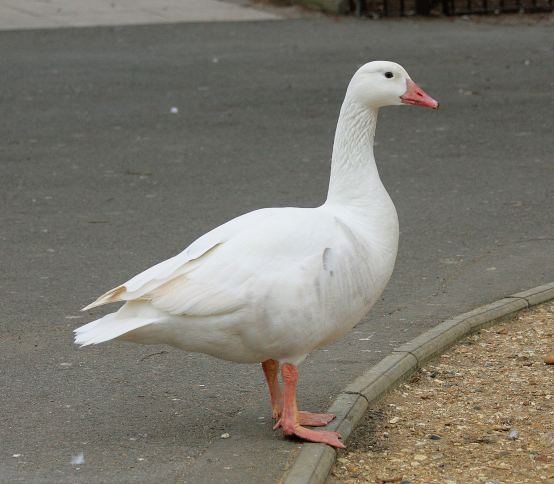
Peter admits knowing
nothing about domestic geese, but after looking up
photos of a pure Embden Goose on the internet (China
blue eyes, tubby two lobbed bottom end, funny shaped
bill), he is sure that the bird at Baffins Pond is not
a pure Embden Goose. He thought it looked similar to
one with darker blue/black eyes, but lacked the jiz
and weird tubby shape that characterises a pure
Embden.
Peter agreed with me that the goose looked nothing
like a Canada Goose, it has none of its features.
However, he thought it could be a white Greylag Goose.
He says, "considering that 50% of all domestic geese
are descended from Greylag Geese, it is no wonder the
bird in the photo looks like a white Greylag with
probably a hint of Embden. Pure Embden Geese are a
very specialist bred goose".
Eric Eddles e-mailed today to say the expert who
identified the Baffins goose as a Embden x Canada
hybrid was Dave Appleton at gobirding.eu. He added
"for about 14 years we had a female Embden on Baffins
Pond which I was told had young in recent years. But
there has never been a male at the pond and she never
flew, so, make your own mind up".
Well, Eric, I am sure Dave Appleton knows a lot more
about domestic geese than I will ever know - and that
probably goes for Peter too. So, we must bow to his
greater knowledge and experience, though it would be
nice to have an explanation of why it is that this
hybrid looks so little like one of its parents.
Just for interest, here is a photo dating back to May
2004 that I found in my files of a Canada Goose family
on the path at Baffins Pond with what I called at the
time an Embden Goose, but I am not sure any more.
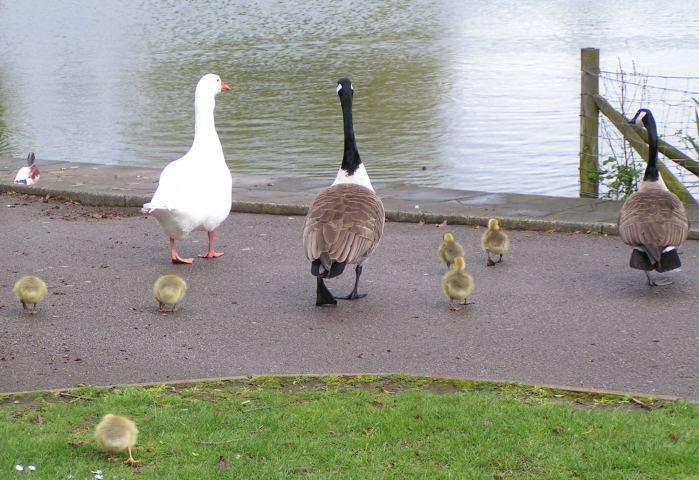
FRIDAY
FEBRUARY 13 - 2015
Emsworth
I had my usual
walk round the millpond. I noticed that the resident
Mute Swan pair did not have their cygnet present for
the first time. It has probably been 'encouraged' to
join the flock of swans in the channel by the quay
which actually contains six immature swans. Quite a
crèche! I walked back home through Brook Meadow
where I took a few photos just for the fun of it.
A
view across the meadow looking east showing the
central line of willows
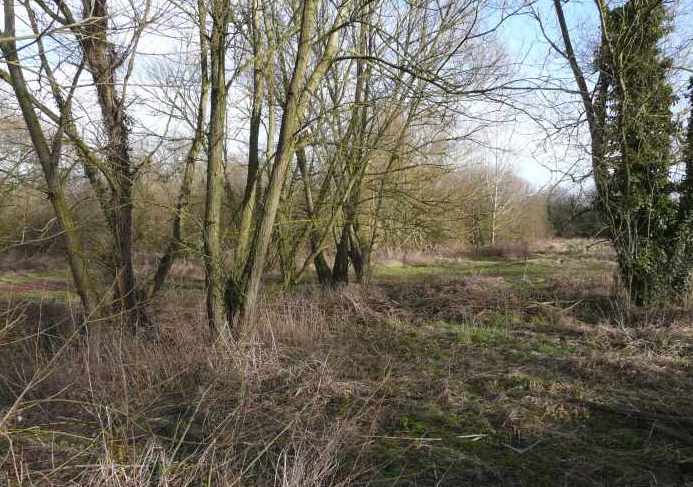
The
north bridge over the river with craggy
willows
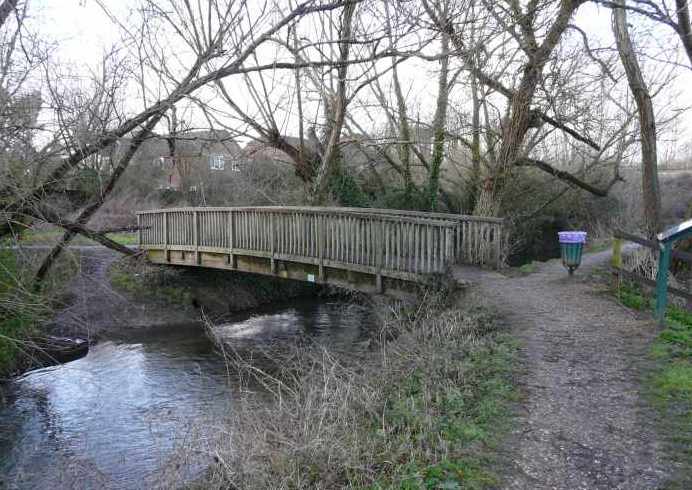
Little
Egrets fighting
Malcolm
Phillips did not find much of interest on Brook Meadow
today so he had a walk around the millpond to Beach
Road. On the way he watched a couple of Little Egrets
seemingly having a fight on the concrete foreshore
immediately beneath the quay. I also saw the two
egrets when I walked round the pond this morning, but
they were peaceful then. What were they up
to?
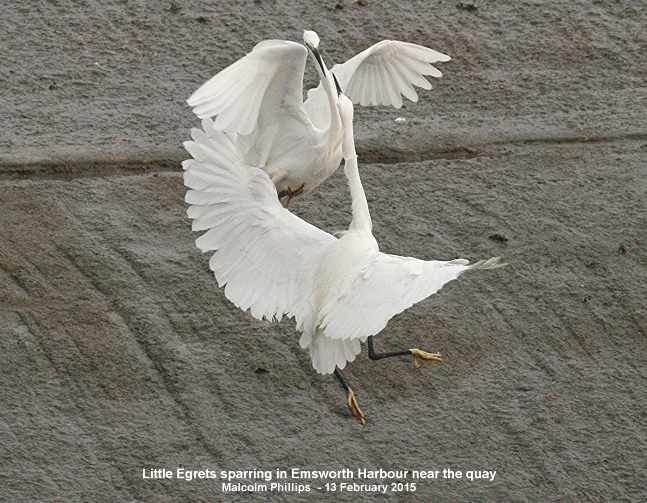
Birds of the Western
Palearctic does not have much to say on the matter of
antagonistic behaviour in Little Egrets away from the
nesting colony except that it does mention chasing and
threat calling has been observed during disputes
between feeding birds. So, the fight that Malcolm saw
could have been a squabble over food.
Putting 'Little Egret aggression' into Google produces
several photos similar to Malcolm's. So, this
behaviour is not uncommon. One web site provided an
excellent sequence of photos of aggression between two
egrets in which one almost drowned the other, though
both birds emerged uninjured at the end of the fight.
This is not unlike the scraps between the swans on the
town millpond. See . . . http://www.images-naturally.co.uk/2014/05/little-egret-aggression.html
Langstone
Mill Pond
Peter
Milinets-Raby popped down to Langstone Mill Pond this
afternoon ahead of the incoming tide (3:04pm to
4:24pm).
Pond: Female Wigeon. Female Goosander on pond from 4pm
and straight to sleep on the tree on the back. 1 Water
Rail swam across the pond from one reed bed to
another.
Grey Herons:- On at least three occasions heard young
begging, but no activity observed in all three
nests.
Off Pook Lane: 220+ Dunlin (just could not find the
sandpiper!). 3 Knot. 40+ Teal. 1 Greenshank
(G//R+BRtag//-) First one I have seen in three visits.
Are they leaving us already? 25+ Lapwing. 1 Turnstone.
7 Grey Plover. 20+ Shelduck. 15 Black-tailed Godwits.
210+ Brent Geese. 651 Golden Plover - counted
in flight from a photo. They landed several times on
the shore, but spent most of the time I was there
swirling around in spectacular flights!
One
of Peter's photos of the Golden Plover in flight.
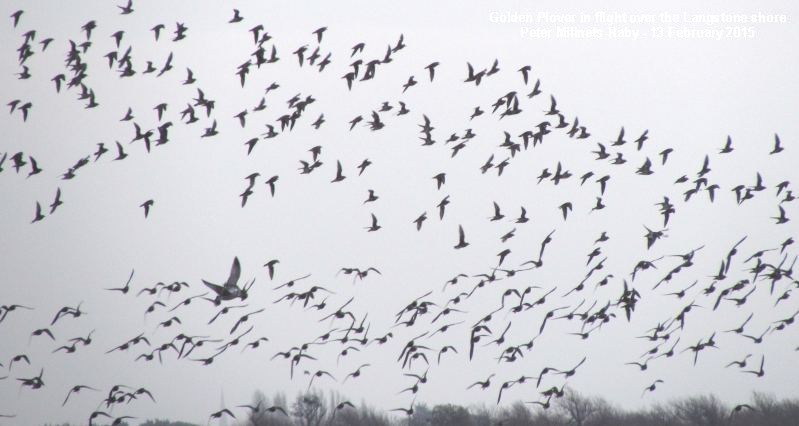
Is
that a Peregrine I spy catching one of the
plovers?
But, Peter says the bird in the photo was a juv
Herring Gull.
Finally,
a Little Egret eating
crab.
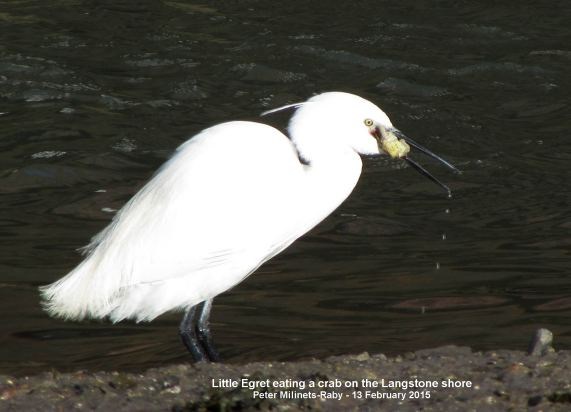
Hybrid
Goose on Baffins Pond
After reading
about the possible hybrid Brent Goose at Langstone in
this blog on Feb 11th, Eric Eddles thought we would be
interested to see a photo of a hybrid Canada Goose x
Embden Goose, which has been coming and going on
Baffins Pond for a number of years.

I must admit that the
bird looks to me like a regular Embden Goose, with
very little of a Canada Goose in it. However, Eric
said it was identified for him by an expert on
hybrids. I would appreciate any other views.
THURSDAY
FEBRUARY 12 - 2015
Hungry
Starling
Glynis Irons
e-mailed to say after much patience and perseverance
they now have regular visitors to their bird feeders.
Glynis and her family in fact live just round the
corner from me. Her 9 year old son Thomas is a keen
birdwatcher and has been using his camera to good
effect in taking photos of the birds in the garden and
very good they are too. Here is an excellent action
photo that Thomas got of a hungry Starling on one of
the bird feeders. See below for more about Starlings.
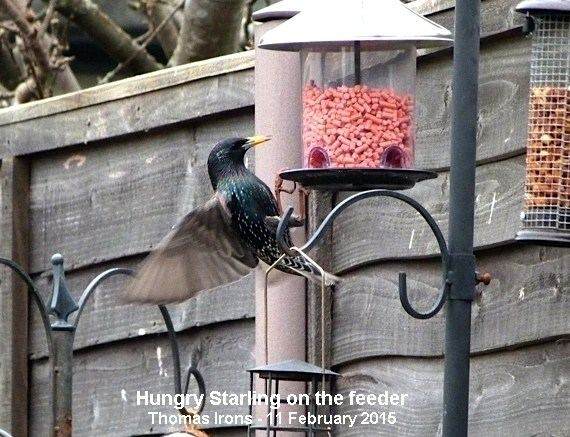
Identifying
Redshanks
Charlie
Annalls walked around the Farlington Marshes reserve
on Saturday 7th February to see the Avocets. She found
them just near the entrance from the Eastern Rd
roundabout. What cracking birds they are.
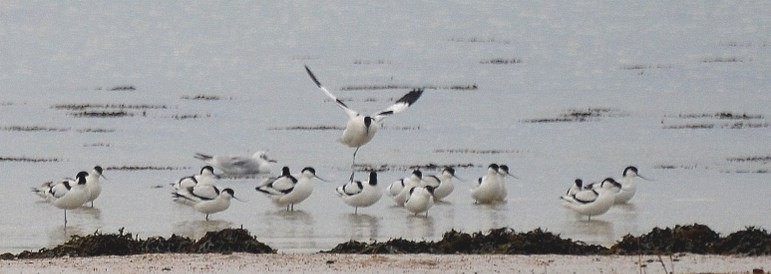
Charlie also saw a
Redshank, but as she is never sure of the differences
between a Common and Spotted Redshank she will leave
me to decide!
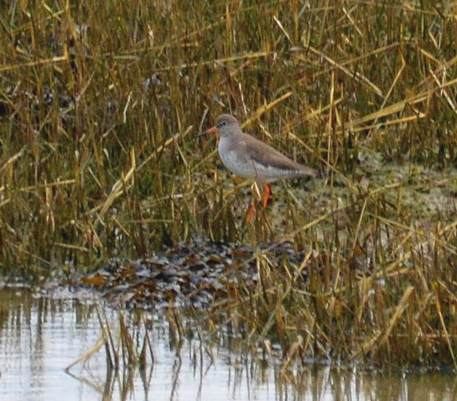
Well, the bird in
Charlie's photo is almost certainly a Common Redshank.
The Spotted Redshank, as well as having a longer bill
and legs, looks brighter and cleaner, being grey above
and white below unlike the brown upper plumage and
streaked underparts of the Common Redshank. The clear
white eyebrows of the Spotshank also produces a
distinctive face pattern, particularly when viewed
from the front.
Mike's
images from QE Country Park
Mike Wells
spent an hour at QE Park today to try and get a better
photo of a Grey Wagtail, which he managed! And
what a cracker it is. PS Don't be tempted to call it a
Yellow Wagtail, which is a quite different bird.
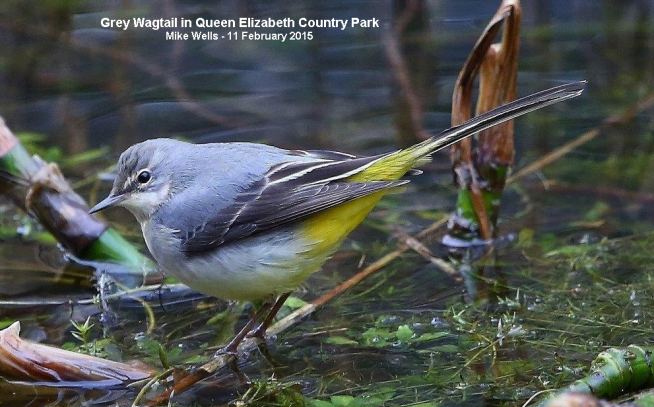
Mike also got this
image of a Robin with a metal ring on its leg.
This will be a standard BTO ring with a unique number
on it, but unfortunately it cannot be read on Mike's
photo. It might well have been ringed by a local
ringer. A good number of Robins do migrate here from
the continent in winter, so it could be one of those,
though I gather the continental birds are much shyer
than our bold residents and Mike's bird looks a very
bold chappie.
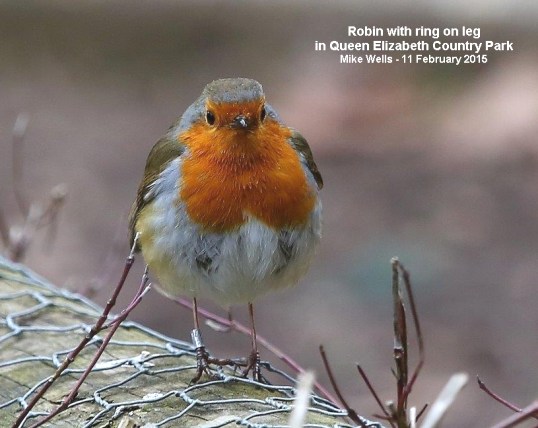
Cuckoos
on the move
BTO reported
on Feb 10th that two of their tagged Cuckoos are
already heading towards the west coast of Africa at
the start of their spring migration. Hennah is now
just inside the border of Sierra Leone in an area
where the Lofa-Mano National Park and Gola North
Forest Reserve meet, where presumably he will rest for
a while after such a long journey in a short time.
Meanwhile, Ash was in Nigeria on the 8 February but by
Feb 9 he was in Ghana, north of Lake Ghana and the
Digya National Park. These two Cuckoos have moved west
a lot earlier than the BTO was expecting.
See . . . http://bto-enews.org/IG4-35G9V-3RN36S-1GUPQR-0/c.aspx
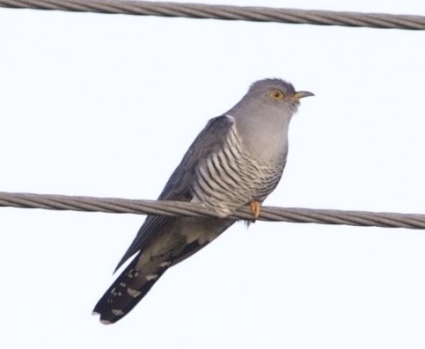
Photo
by Richard Somerscocks on North Thorney - April
2012
Focus
on Starlings
Starlings are
the BTO bird of the month. Roosting communally, vast
flocks of Starlings may congregate at favoured sites,
typically performing aerobatic displays, known as
'murmurations'. Here is a photo of one such display
from the BTO site by Jeremy Moore.
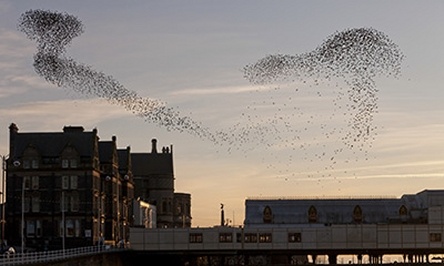
Starlings show
adaptability when it comes to food and feeding, which
has helped them to adapt to our urbanising landscapes.
However, the loss of suitable nesting cavities, under
roof tiles or within barge boards and soffits, is
thought to have contributed to the decline in
populations over the last few decades. They will,
however, take readily to nest boxes of suitable
size.
Read more at . . . http://bto-enews.org/IG4-35G9V-3RN36S-1GUPQQ-0/c.aspx
WEDNESDAY
FEBRUARY 11 - 2015
Tagged
Greenshank in harbour
My morning
walk round the millpond produced only one observation
of interest. This was a colour-ringed Greenshank
G+BN tag feeding in the outlet channel from the
town millpond next to Emsworth Sailing Club. This bird
is fitted with a geotag attached to the blue ring,
which will provide information about the movements of
the bird on migrations to and from its breeding
grounds. This was one of 13 Greenshank caught and
ringed by Pete Potts and his team at Thorney Deeps on
Jan 13, 2014. It has been a regular in Emsworth
Harbour, this being my 5th sighting of it this winter.
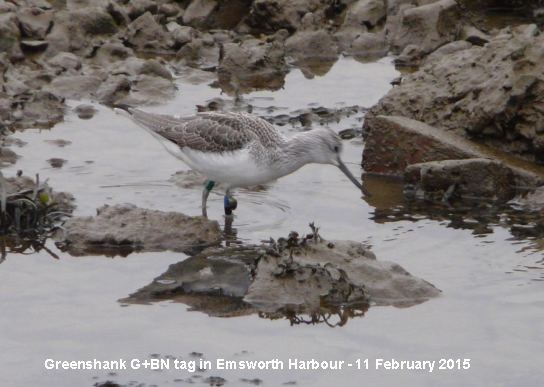
Molehills
on Brook Meadow
Coming back
home through Brook Meadow I came across a line of
molehills along the path crossing the centre meadow
from the Lumley gate. I counted a total of 172, though
many of them had been walked on and scattered. I could
see a good number of molehills elsewhere on the
meadow, though the total would be nowhere near the
1,110 hills I counted in February 2005. For more
details about that bumper year for molehills go to . .
. http://www.brook-meadow.hampshire.org.uk/bm-moles.html
Photo
shows the molehills I counted on the path looking
towards the Lumley gate
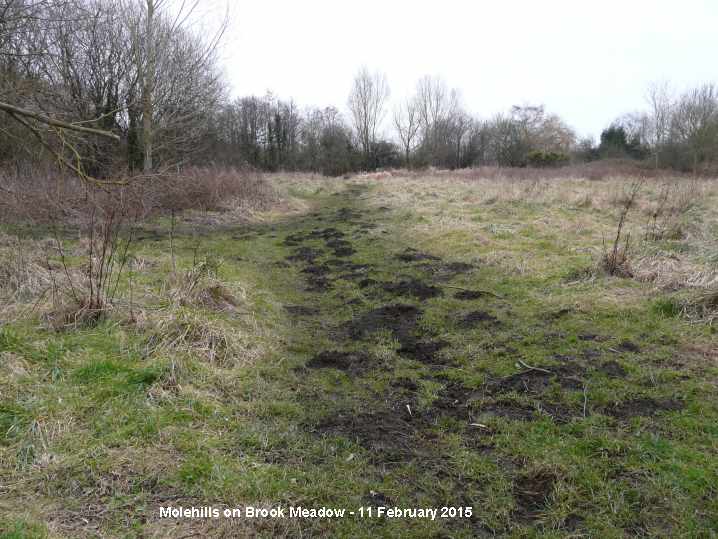
February is a
generally a good month for molehills, being the time
of year when the tunnel systems are being enlarged in
preparation for the breeding season. The tunnel
system, which is the permanent habitation of the mole,
acts as a food trap, constantly collecting
invertebrate prey such as earthworms and insect
larvae. As they move through the soil, invertebrates
fall into the mole run and often do not escape before
being detected by the patrolling resident.
First
Celandine on Brook Meadow
Malcolm
Phillips found the first Lesser Celandine on Brook
Meadow today on the river bank just south of the north
bridge. This was, of course, not the first Celandine
of the year anywhere as I have seen one in Bridge Road
car park on Jan 27th and Ralph Hollins has seen many
flowering in Havant. However, the first one on a site
is always good to see as a 'sign of spring'.
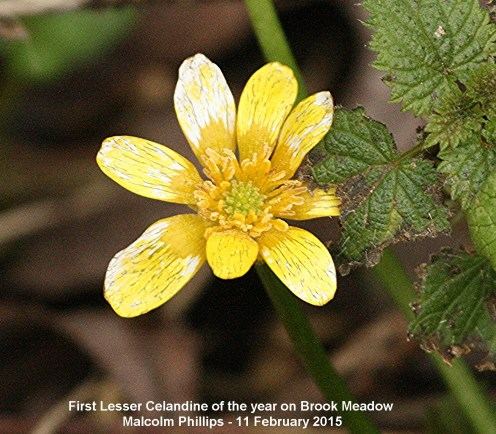
Bird
song
Another good
sign of spring is bird song. Many birds can now be
heard singing on and around Brook Meadow including
Wren, Robin, Dunnock, Great Tit, Goldfinch, Starling,
House Sparrow, Collared Dove, Woodpigeon and Song
Thrush. Ralph Hollins also heard the first snippet of
Chaffinch song in his garden as he set out for his
walk this morning. Bird song which is usually only
from males (except female Robins also sing in winter)
has two main purposes: 1 to establish breeding
territories and deter rivals and 2 to attract mates.
Malcolm Phillips was on the meadow today and captured
this Wren launching into its loud and elaborate
song which I gather contains over 100 separate notes!
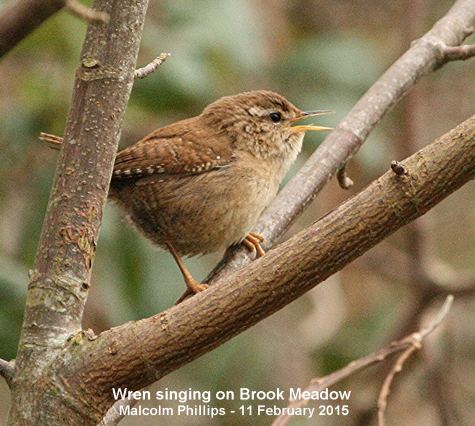
Spotted
Redshanks
Ralph Hollins
notes on the HOS sightings that there was a Spotted
Redshank at Farlington Marshes today (east side near
eastern entrance). A search for Spotshanks at
Farlington since Jan 1 gives just three sightings (two
in January on or near the main lake plus this one
today). Ralph wonders if any of the Spotted Redshanks
seen at Emsworth might have flown to Farlington.
My impression is that the Emsworth Spotted Redshanks
tend to go in the other direction towards Thorney
Island where there is a regular roost of up to three
birds. Most recently, Barry Collins found 3 Spotted
Redshanks at Thorney Deeps during his Webs count on
06-Dec-14.
Wintering
Blackcaps
Tony Wootton
got an excellent photo of a female Blackcap that
turned up in his Emsworth garden this morning, the
first for a few weeks. Tony says the male Blackcap is
a more frequent visitor. I tend get a regular female
Blackcap in my garden, rarely a male. The male has a
black cap and the female a brown one.
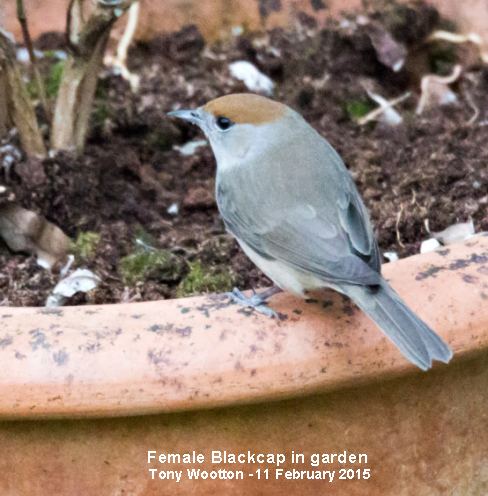
Tony asks if he is
right in assuming that, as winter visitors from the
continent, Blackcaps will soon be leaving rather than
staying and breeding. The answer is yes. The ones we
get in our gardens in winter will be returning to
their breeding grounds in Central Europe. This has
been proven by ringing studies. Our summer visitors
that breed here are a different population, though
they are the same species. As far as I am aware the
two populations do not overlap.
BTO research shows an
increasing number of Blackcaps that breed in central
Europe are coming to the UK to spend the winter here
instead of travelling to the Mediterranean, where they
would normally go. In Britain, food provided in
gardens, coupled with our warming winter climate, is
helping Blackcaps to survive. The reward for enduring
harsher winter conditions here rather than in the
Mediterranean is that our wintering Blackcaps have a
shorter journey back to central Europe in the spring,
meaning that they can stake early claim for the best
territories. Central European-breeding Blackcaps that
winter with here have been found to lay more eggs and
fledge more chicks than those that winter further
south.
For a useful fact sheet about wintering Blackcaps see
. . . http://www.bto.org/sites/default/files/u23/downloads/pdfs/factsheet_blaca.pdf
Langstone
Mill Pond
Peter
Milinets-Raby had a quick hour down the Langstone Mill
Pond this afternoon from 3:07pm (almost high tide).
The highlights were as follows:
Pond: Female Goosander at the rear of the pond on the
water by the tree asleep. No Wigeon present? 4 Grey
Herons roosting. 2 Stock Doves.
The top Grey Heron nest in the Holm Oak was visited by
the male bird today and the female bird stood up and
between them they tended to 'things' that were out of
sight at their feet in the nest and obscured by
foliage. Their actions suggested young. And the noise
I could barely hear was that of young begging. See
link below: (the same begging noise I heard the other
day, but could not place. (Marked XC118495). So I
believe, both nests in the Holm Oak are with very tiny
young.
http://www.xeno-canto.org/species/Ardea-cinerea?dir=0&order=typ&view=3
Paddock: 20 Moorhen, 23 Teal.
Hybrid
Brent Goose?
Peter sent me a photo of what he thinks might be a
hybrid Brent (on the left), which he says looks as if
it has some Black Brant in it. He also sent a normal
Brent for comparison (on the right). All I can say is
that Brent Geese in my experience do vary a good deal
in the lightness of their flanks. Whether this is a
hybrid I have not the faintest idea, though I do
recall Jason Crook telling me some years ago about the
difficulty of this identification.
TUESDAY
FEBRUARY 10 - 2015
Spotted
Redshank at Nore Barn
In response to
my request for Spotted Redshank sightings, Martin
Hampton e-mailed to say he saw one in the usual stream
at Nore Barn on Feb 1st. This is good news as I had
received no other sightings of the bird since Jan
22.
I decided to cycle over to Nore Barn to have a look
for myself this morning. I got there at about 12 noon
when the tide was still very low, not the best
conditions to see the Spotted Redshank. However, to my
delight there it was feeding alone in the stream. It
stayed for about 15 minutes during which I took some
photos of it - not that I am short of photos of this
very popular bird! Then, all of a sudden, it shot off
somewhere giving its characteristic 'chewitt' call as
it went.
Here
is a selection of photos I took of its feeding
today
There were no other
birds of special interest in or around the stream. In
fact, the harbour as a whole was remarkably empty of
birds, with just a few Brent Geese, Wigeon, Teal,
Dunlin and Black-tailed Godwits dotted around. Are the
wintering birds starting to move off already, I
wonder?
Millpond
News
The Mute Swan
family with one cygnet are still together on the town
millpond near the bridge where they nested last year.
I think most other Mute Swan pairs are now back on
nesting territory having chased off their youngsters
from last year.
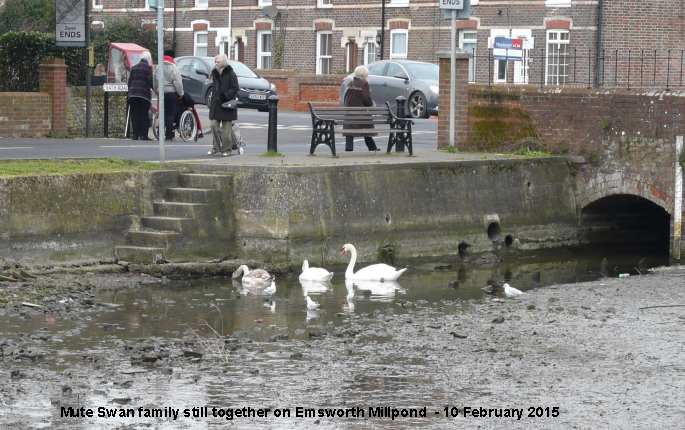
I noticed that the
council workers had been clearing the 'weeds' from the
edges of the millpond seawall when I passed by this
morning. I think there have been complaints about the
appearance of the millpond wall. Personally, I admire
the wild plants that manage to eke out a living in the
harsh habitat of the seawall. But thankfully, the
workers were chopping the plants off at their bases
and not spraying them with anything nasty, so
hopefully they will grow again with renewed vigour
next time.
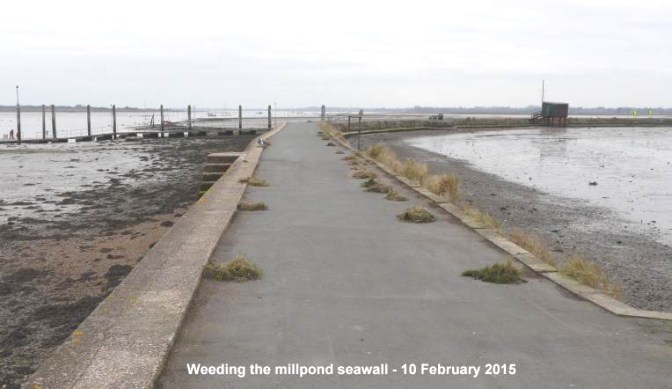
Hampshire
Farm has problems
Chris Oakley
made a trip over to Hampshire Farm, the first for many
weeks. Here is his depressing report, which could well
be his last. I hope not:
"Two Skylarks, one Buzzard, one Carrion Crow as well
as twelve Black-headed Gulls were on the pond. I had
reports from friends that the place had deteriorated
but I never expected to see it like it was this
morning. It has become no more than an exercise area
for dogs. Bearing in mind that this was a dull Tuesday
morning, I counted twelve dogs running loose. One
friend said he had seen more than twenty on another
occasion. There is dog mess everywhere and those
people who have picked it up just leave the bags
behind. There was only one bag in the bin provided.
Even the children's play area is fouled, their sand
pit seems to be the first place dogs head for.
Naturally the deer have gone, I gather there haven't
been any around since December. Three of the five log
piles have been vandalised with wood strewn all
around. A car tyre has been dumped in the stream
together with plastic containers and cans. The
northern fence line has been broken through in a
couple of places. The pond is littered with rubbish,
even the lifebuoys are missing. I suppose all this was
to be expected with the influx of hundreds of people
alongside, although to be fair dog owners from all
over the area descend on the small car park each day.
You will gather that I have become disillusioned by
all this, in fact so much so, that I will be giving up
reporting from the farm and will be closing the web
site. There are still a few weeks left before it is
due for renewal and if you know of anyone willing to
take it on please let me know. It is with great
sadness that I have come to this decision after five
eventful years, but I am fully aware that I would be
constantly depressed by having to see this site
degenerating. After my operation I hope to be back in
circulation and, if I may, I will still send in
anything of interest from around the district".
This is a very sad
situation, but predictable with the presence of a free
car park and lots of open space. Nore Barn has a
similar problem, though there is a good conservation
group there which copes very well with a difficult
situation. Brook Meadow is lucky in not have easy and
free parking nearby, so mainly attracts locals. It
also has a strong conservation group which stand for
no nonsense. Chris has done a good job in keeping
wildlife records for the Hampshire Farm site, but the
job of protecting the site is too much for one person.
What the site needs is a really strong conservation
group to sort things out, but that is not easily
achieved in the short term. If you have any ideas on
how this situation can be resolved please write in.
Garden
birds
Patrick Murphy
sent me two photos of birds that visit his garden in
North Emsworth regularly. The Coal Tit is one of a
pair that is feeding on niger seed but also feeds on
sunflower hearts and bird cake. The Song Thrush is one
of the pair that normally feed on the ground, but this
chap has found the way onto the bird cake. Good for
him (or her)!
Red
Kite over Emsworth
Neill and Jill
Foster saw a Red Kite at 12:00 noon today, drifting NE
over the bottom of North Street and then onto Brook
Meadow. Neil says when they were in Bucks, the Red
Kites would usually be mobbed by Carrion Crows; this
one was being seen off by a couple of gulls! This was
an interesting sighting as Red Kites are quite rare in
our area, though they are occasionally seen, mostly
over the woodlands of Hollybank Woods and Stansted
Forest. Any other sightings of this magnificent bird
please let me know and keep looking up!
Blue
Tits fighting
Brian Lawrence
had a walk round the meadow today and witnessed some
strange behaviour by two Blue Tits in a tree by the
north bridge. Brian says at first they seemed to be
flirting in the tree, but then, joined together by
their feet, they fell to the ground and flapped about
together before flying off still attached. Brian
wonders if this is this mating behaviour. It seems
more like a territorial dispute to me.
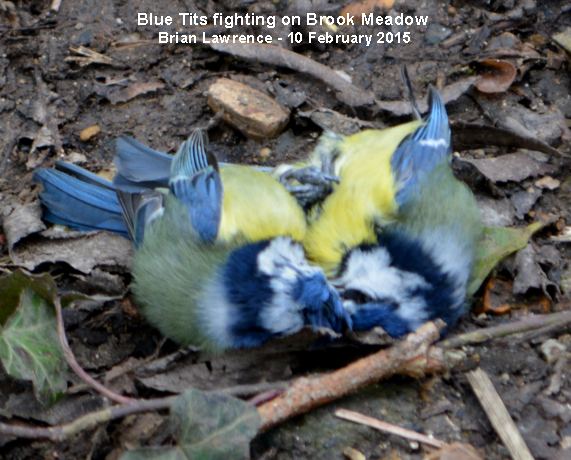
Put 'Blue Tits
fighting' into Google will produce a host of links for
this behaviour plus a couple of YouTube videos. So it
is clearly not uncommon. One of the videos is quite
astonishing. It shows two Blue Tits so engaged that
they allowed the observer to pick them up and try to
separate them, but they still continued to scrap.
See . . . https://www.youtube.com/watch?v=uMHsMPs5gC8
Giant
Butterbur at Langstone
Ralph Hollins
reports in his diary for Feb 9 that a dozen plants of
Giant Butterbur (Petasites japonicus) were
flowering near the Langbrook Stream - on the bit of
waste ground adjacent to the bridge connecting the
one-time Langstone Dairy Farm to the Moors where the
cattle would feed. Ralph tells us the plants were
planted around 1970 when IBM acquired the land
stretching down to the harbour and built their
manufacturing plant (now the Langstone Technology
Centre).
Unfortunately, the plants were not at their best when
Ralph saw them yesterday, their leaves were damaged
and their flowers blackened by frost. However, at
their best they look rather like small flowering
cauliflowers. Here is a photo I took of a Giant
Butterbur in flower a few years ago along with a
couple of spikes of the female Butterbur (Petasites
hybridus).
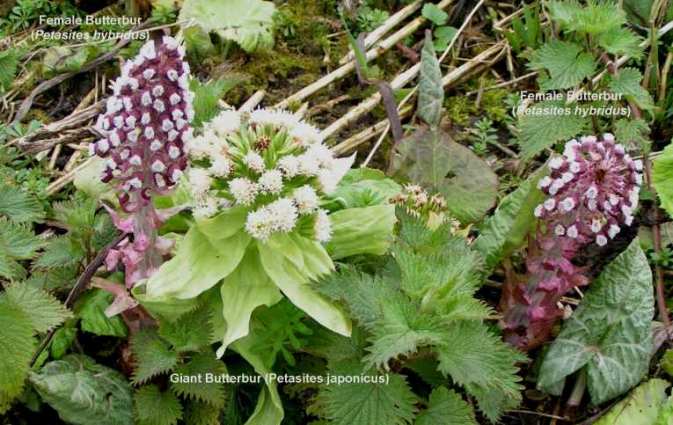
Female Butterbur was
also planted in this area at the same time as the
Giant Butterbur and are usually far more prolific,
though it is a bit early for them at the moment. They
should be good in a month or so. Female Butterbur is
common in the north of England, but rare in the south;
the plants on Brook Meadow are all male. Butterbur
reproduces vegetatively so the male and females do not
need each other!
Swans
on Canoe Lake
Following the
comments about the return of Mute Swans to Canoe Lake
(see blog entries for Feb 5 and Feb 6) , HOS Recorder,
Keith Betton, checked the HOS database and found there
were no more than 3 reported to HOS in 2005/2006 - and
no more until 2013 when there were 16 on 14/11 and 21
on 26/12. He has yet to look at the 2014 data. So, it
appears that the swans started coming back to Canoe
Lake in the winter of 2013-14. I wonder what brought
them back? Maybe, some are from the displaced Emsworth
Millpond flock?
Albino
Squirrel in Southsea
Graham Petrie
took this picture this morning in Southsea on the
corner of Villiers Road. He asks if he is right in
thinking this is a "proper" albino squirrel because of
the eye colour?
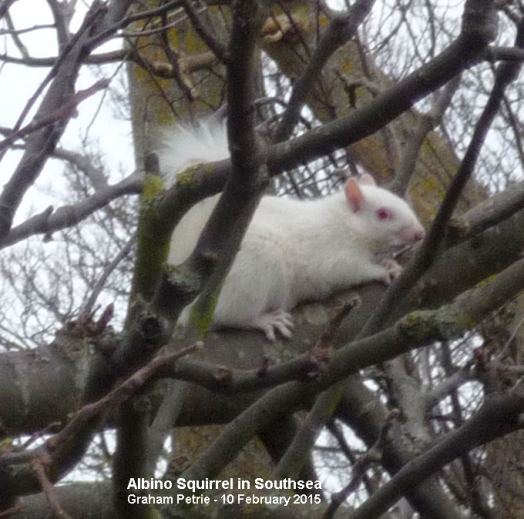
John Goodspeed has
made a special study of albino squirrels which
apparently are frequently seen and reported around the
Portsmouth area and further afield. John's web site
has a special page for the albino squirrel with
records of sightings and pictures. He says, "Only a
few white squirrels are albinos, recognizable by pink
or blue eyes and the absence of pigmentation anywhere
on the body". Thus, Graham's squirrel would seem to
qualify as albino according to this definition. John
adds, "Albino squirrels have vision problems and are
at a disadvantage in the wild".
For more information go to John's web page at . . .
http://www.havantnature.net/white_squirrels.html
MONDAY
FEBRUARY 9 - 2015
Emsworth
Harbour
I cycled over
to Nore Barn along Western Parade this morning at
about 11:30 with the tide rising to high water at
14:30. The weather was cloudy, dull and chilly, but
the cold northerly wind that we have been enduring for
the past week or so had dropped. The main western
mudflats were fairly empty of birds but for small
numbers of Brent Geese, Wigeon and Teal along with a
few Shelduck. Dunlin were feeding in small groups here
and there on the mudflats. I counted a total of 39
Black-tailed Godwits, none of them had rings.
The only bird in the stream was the colour-ringed
Greenshank G+GL, looking very lonely feeding on
its own. There has been no report of Spotted Redshanks
at Nore Barn since the two I saw there on Jan 22. That
is a little worrying.
I kept an eye out for the Spoonbill that Peter
Milinets-Raby saw flying in this direction yesterday,
but there was no sign of it.
The best birds of the morning were undoubtedly the
Pintail of which I counted 40, though I could
well have missed some. This is not a record as I had
54 in the harbour on 14-Feb 2012. They all flew off
together at about 12.30. They are such beautiful
elegant ducks. Here is a digiscoped photo of two males
and a female.
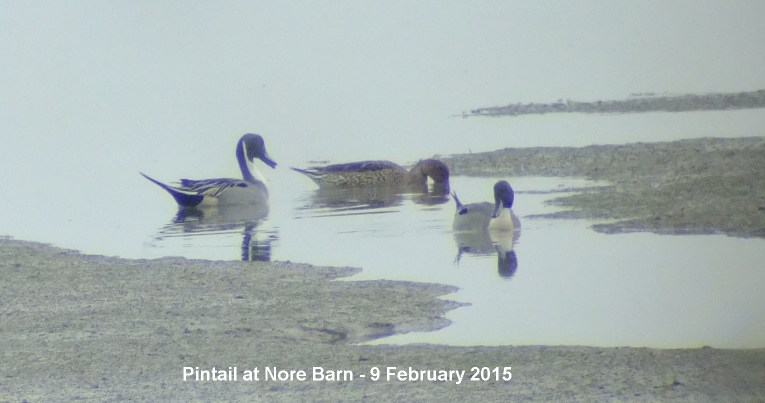
Langstone
Mill Pond
Peter
Milinets-Raby had a late morning visit to Langstone
Mill Pond on an incoming tide (11:37am to 1:25pm armed
with an old Mighty Midget toy scope that he found in a
dusty cupboard over the weekend). The highlights were
as follows:
Pond: Female Wigeon. Male out on the salt marsh by the
mill and returned to the pond at 1:15pm when the tide
pushed in fully. Water Rail heard only. Male
Bullfinch. 2 Stock Doves. 6 Teal.
Adult Grey Heron visited the top nest in the Holm Oak
twice and lots of clucking noises from the other nests
- heard this sound before, not quite sure what the
birds are doing. I think there are just having a
general conversation about how there days have
gone!
Horse paddock: 28 Moorhen. 7 Teal. Grey Heron
collecting small twigs.
Off Pook Lane: Ahh the Dunlin were back in numbers.
520+ Dunlin. 1 winter plumaged Curlew Sandpiper -
surprisingly easy to pick out, though half the flock
flew off early to roost and took the sandpiper with
them. 30 Knot. 44 Lapwing. 199 Golden Plover. 63
Shelduck. 8 Grey Plover. 35 Wigeon. 480+ Brent Geese.
11 Bar-tailed Godwit with a flock of 120+ flying in to
roost on the island. 12 Black-tailed Godwit. 1 male
Red Breasted Merganser. 13 Canada Geese. Amazingly 10
Turnstone!!! 40+ Teal.
Avocets
at Farlington
Brian Lawrence
had a walk around Farlington Marshes today and saw the
flock of Avocets that has been on the reserve for some
time. Caroline French saw a flock of 60 on Feb 6.
These birds are likely to be from the breeding grounds
in Eastern England. Brian sent me this photo of some
of them.

Egyptian
Geese at Petersfield
Graham Petrie
went to the Hampshire Ornithological Society (HOS)
walk in Buriton and Petersfield where he saw 46
species in total, including this pair of Egyptian
Geese on Petersfield Lake (Heath Pond).
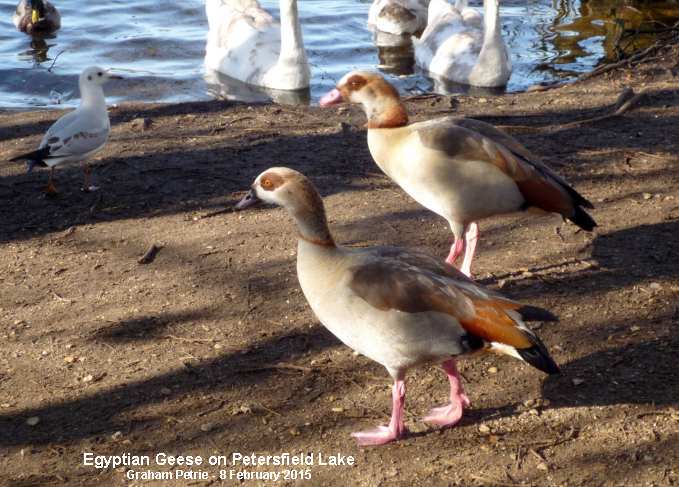
The Egyptian goose
(Alopochen aegyptiaca) is native to Africa
south of the Sahara and the Nile Valley. Egyptian
geese were considered sacred by the Ancient Egyptians,
and appeared in their artwork. They have been raised
for food and extensively bred in parts of Africa since
they were domesticated by the ancient Egyptians.
Because of their popularity as ornamental bird,
escapes are common and small feral populations have
become established in Western Europe, particularly in
Eastern England and the Netherlands.
In Hampshire the stronghold of the Egyptian Goose is
in the NE of the county and in the Avon Valley, but it
is increasingly recorded in other areas. The Hampshire
Bird Report for 2012 reports a brood at Petersfield
Lake but no young survived.
SUNDAY
FEBRUARY 8 - 2015
Brook
Meadow
Malcolm
Phillips had a good morning on Brook Meadow with his
first Primrose and butterfly for this year. The
Primrose was seen along the path through Palmer's Road
Copse and was probably one of those planted several
years ago by the council which come up reliably each
spring. Primroses also usually come up along the north
bank opposite the railway embankment. These were also
planted, privately!
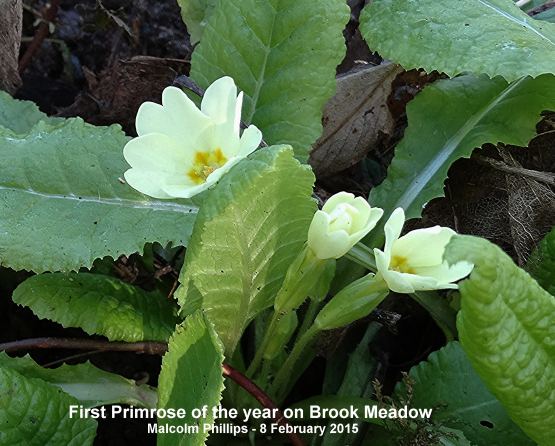
The Red Admiral
was basking in the warm winter sunshine along the
north path. This insect will have been woken by the
rise in temperature today. Another butterfly I am
expecting at this time is Brimstone - particularly the
bright yellow males which often flutter through
gardens.
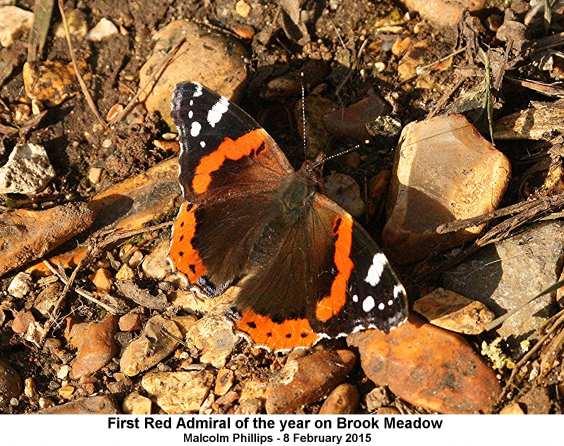
Malcolm also caught a
Blue Tit exploring one the concrete nest boxes
which were erected in Palmer's Road Copse several
years ago, most of which have now disappeared with the
constant loss of trees and branches in that area.
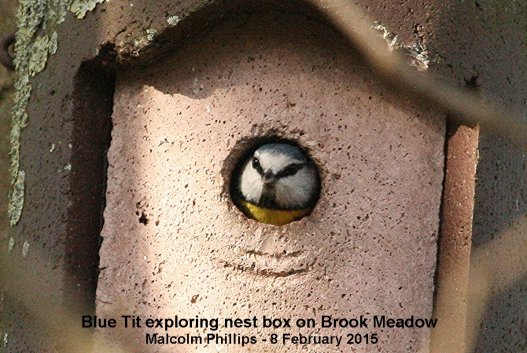
Warblington
shore
Peter
Milinets-Raby went out for a walk along the
Warblington shore this morning five minutes after
sunrise (7:35am to 9:18am - low tide - still no
scope). Here is Peter's report:
"Ibis Field: 7 female & 1 male Pheasant, Song
Thrush, Meadow Pipit over calling, 1 Moorhen, 2 Stock
Doves.
Conigar Point: 9 Teal, 43 Wigeon, 21 Shelduck, 1
Little Egret, 23 Dunlin, 40+ Brent Geese, 2 male &
1 female Pintail, 1 Greenshank, 3 Grey Plover, 5 Red
Breasted Merganser, 2 Bar-tailed Godwits.
Off Pook Lane: 7 Red Breasted Merganser, 237 Dunlin, 1
Greenshank (R//G+YY//-), 69 Shelduck, 42 Bar-tailed
Godwit, 38 Wigeon, 1 solitary Knot, 268 Golden Plover,
8 Grey Plover, 17 Lapwing, 12+ Teal, 9 Black-tailed
Godwit, 120+ Brent Geese, Skylark heard flying over.
Spoonbill
At 8:04am
Peter saw a juvenile/first winter Spoonbill fly
over Conigar Point keeping close to the shore. It
headed east and cut across the fields and it looked
like it was about to land somewhere in the Emsworth
area. (Later at 9:22am to 9:46am he visited the pond
at the top end of Nore Barn just in case it had landed
there. Nothing. Out on the low tide mud of Nore Barn
were 22 Pintail, 8 Black-tailed Godwits and the usual
colour ringed Greenshank in the Nore Barn stream
G//R+GL//- plus all the usual Wigeon, Teal etc.)
So, Spoonbill is another new bird for Peter to add to
the 'patch'. 2015 has been a productive so far for him
with with Avocet, Barnacle Goose and now Spoonbill.
Spoonbill has been recorded before in the area.
Certainly in Emsworth in Dec 2002. Here is a photo I
took of the only Spoonbill I have ever seen in
Emsworth Harbour in December 2002. A memorable
occasion! I recall it even came onto the town
millpond!
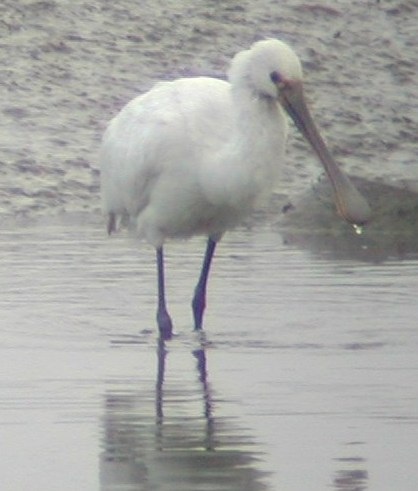
Farlington
Marshes
Mike Wells
spent about 3 hours on Farlington Marshes late morning
and said it turned out to be a very warm, windless
session, most enjoyable. He saw a variety of common
birds, and got a photo of what thought might be a
fluffed up Meadow Pipit. However, the raised crest
suggests a Skylark. Mike said other birdwatchers saw a
Dartford Warbler and Bearded Tits, but he didn't!
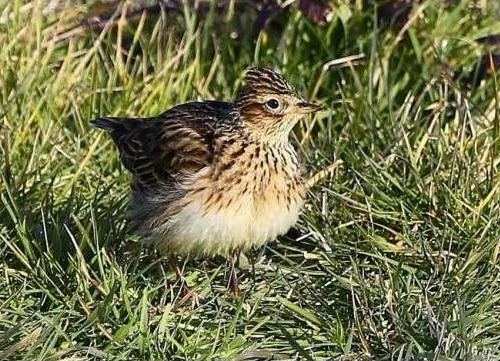
SATURDAY
FEBRUARY 7 - 2015
Brook
Meadow
Malcolm
Phillips did his daily walk around the meadow with his
trusty camera at hand. There was nothing special
today, but Malcolm did get nice shots of three of our
regular resident birds, Song Thrush, Blackbird and
Blue Tit.
Cams
Hall
Heather Mills
reports on this morning's walk by the Havant Wildlife
Group. They saw lots of birds in Fareham Creek
including male and female Goldeneyes. Here is a
female
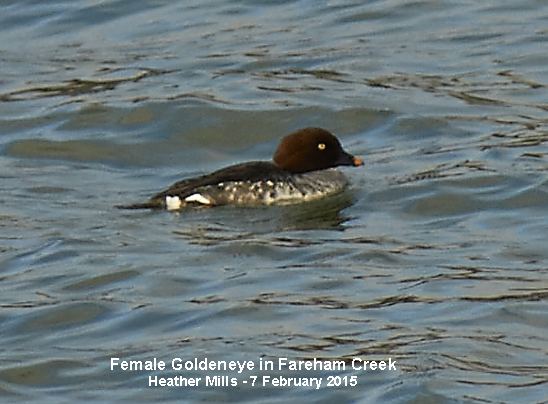
Full report is at . .
. http://familyfellows.com/hwg-walk-reports-2015.htm
FRIDAY
FEBRUARY 6 - 2015
Nore
Barn
I walked to
Nore Barn along Western Parade which was largely
shielded from the strong NE wind, unlike the town
millpond which is totally exposed. I got there at
about 12 noon, about 1 hour to high water, so the tide
was well advanced. However, some birds were still
feeding in the stream. These included the
colour-ringed Greenshank G+GL which has been a
regular feeding companion of the Spotted Redshank. I
had not seen this Greenshank for some
while,
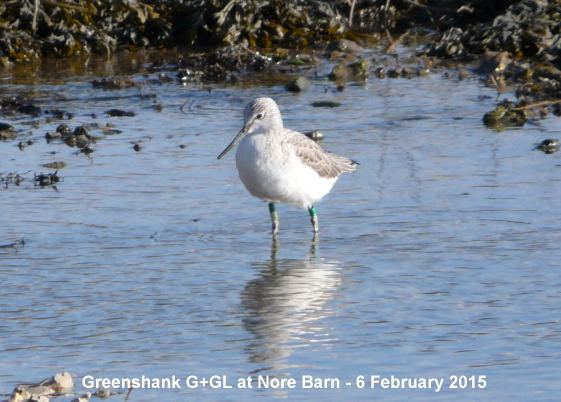
Also in the steam were
a Common Redshank and a Black-tailed Godwit but no
Spotted Redshank. Here is a shot of the Greenshank and
the Redshank feeding together with feathers ruffled by
the wind.
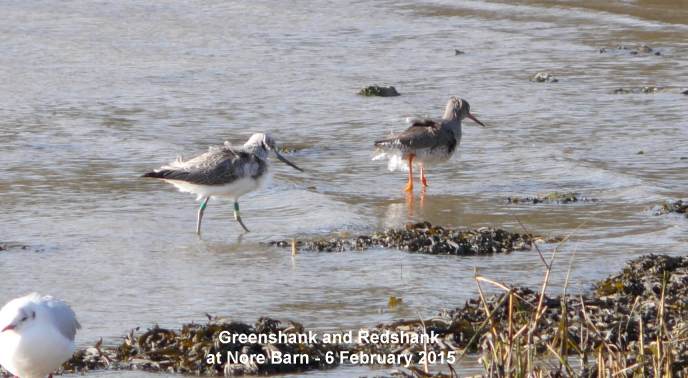
Lots of Brent Geese
were gathered along the shore, but there was no way I
could determine their sexes. I think sexing might be
easier earlier in the season when the families arrive
with two parents.
Brook
Meadow
Malcolm
Phillips went round the meadow today, but did not see
much of interest. He found a Robin with what looks
like a missing or deformed right foot. Let's hope it
manages to cope with life.
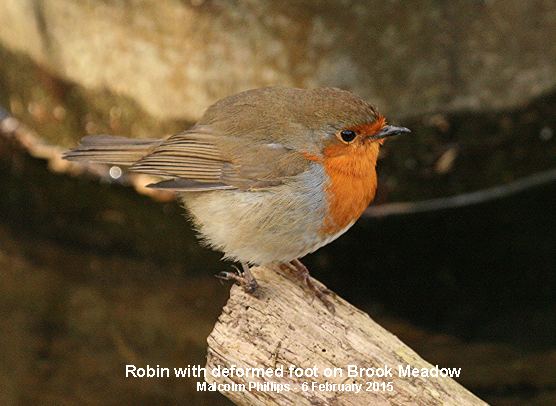
Swans
at Canoe Lake
Following my
report about the return of Mute Swans to Canoe Lake in
yesterday's blog, Ralph Hollins used the HOS reports
Search facility and discovered, as I suspected, that a
flock of swans has been present on the lake for much
of the winter. Mike Wearing has counted the Canoe Lake
Swans on three occasions this winter giving counts of
27 on Nov 2, 30 on Jan 27, and 49 on Feb 2 so my 51 on
Feb 5 shows a growing number, perhaps coming to the
lake in the hope of being fed and/or finding somewhere
warmer than where they had been.
How
to sex Brent Geese
Peter
Milinets-Raby replied to my query in yesterday's blog
(Feb 5) about how to distinguish between male and
female Brent Geese.
Peter writes: "I thought this was general knowledge,
or is it just me, watching too many Brent Geese and
seeing differences between the sexes. I attach a
couple of photos (one deliberately over exposed) to
illustrate the difference in head shape, bill length
and feathering to the bill that I always thought was a
sure way to identify male and female Brent Geese when
they are very close, as well as the obvious features
of heavy build, thicker neck with slightly larger neck
patch of the male (which you have already pointed
out).
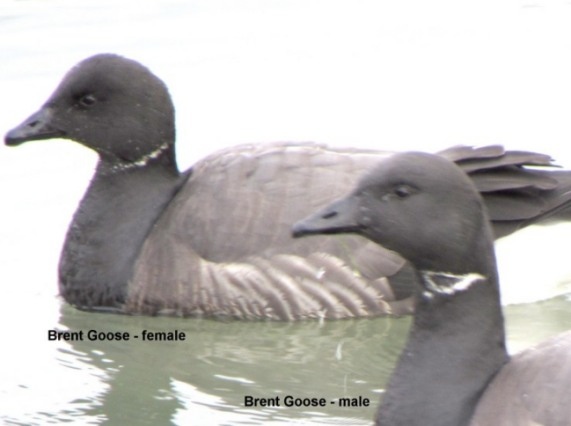
Head shape: Female
head shape is rounder, more circular with a high crown
that makes the eye position seem more in the middle of
the head than a male. The head shape of a male always
seems flatter and thus oval in general shape and to me
always looks as if he has a lump of food in its cheek,
giving the chin area a bulbous look. The eye always
looks to have a "mean" expression.
Bill: Females have
cute small bills with a swollen tip and it often looks
as if the feathering extends along the lower mandible
(though this is only a trick of the light). The bill
on some males can look very ugly in shape with lots of
bulges, but generally is longer, more triangular in
shape with the illusion of a broader base caused by
the positioning of the feathering.
Obviously combining all these features at close range
can make the sexing of Brent Geese relatively easy,
though if it is full proof I do not know. I hope this
is all ok and can be discussed further, but this is
how I sex Brent Geese."
Avocets
at Farlington
Caroline
French saw 60 Avocets on the Lake on Farlington
Marshes today - the most she have ever seen there (or
anywhere! )
THURSDAY
FEBRUARY 5 - 2015
Swans
return to Canoe Lake
Jean and I
went into Southsea this afternoon for some shopping.
On the way, we passed Canoe Lake, on which I was
surprised to see, a large flock of 51 Mute Swans. This
was similar to the number I used to find there when I
did regular weekly counts in the late 1990s and early
2000s. However, swans have been very scarce on Canoe
Lake since then. I think today's flock could have been
on the lake through the winter period as this was my
first visit since last summer. Maybe, someone else has
seen them?
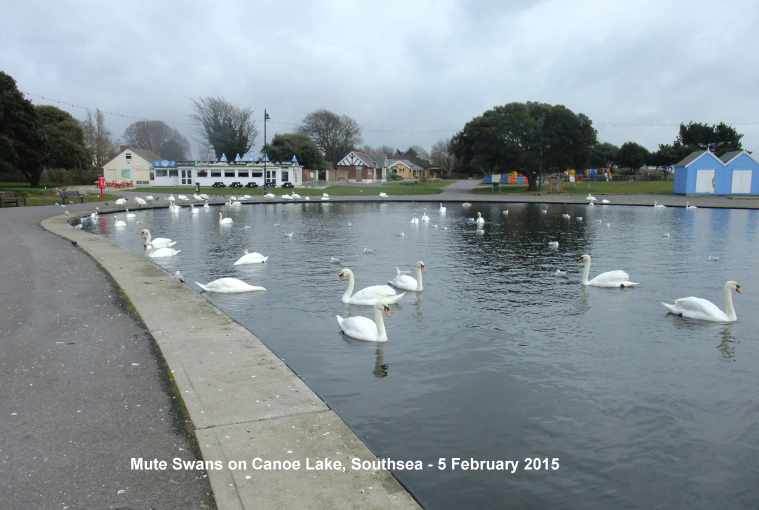
My maximum swan counts
on Canoe Lake for the years 1996 to 2005 are shown in
the following chart plus figures from the Hampshire
Bird Reports for the years 1980 to 1990.
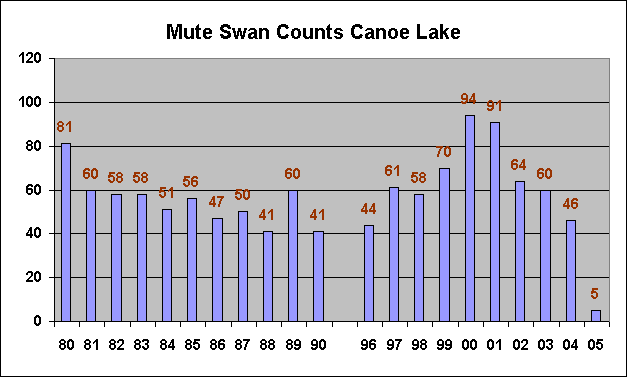
As can be seen, in the
years 1996 to 2002 the maximum winter counts were
usually above 60 and reached a peak of 94 in the year
2000. However, from 2002 numbers plummeted to just 5
birds in 2005, when I finished regular counting. I am
not sure what happened, but I do know that coincided
with the Council asking people not to feed the swans
as the food was contaminating the lake. Since 2005 I
have looked at Canoe Lake when passing, but never
found many there until last year when I counted 23 on
5 March 2014. So maybe they are coming back? I did not
see anyone feeding them.
Langstone
Mill Pond
Peter
Milinets-Raby visited Langstone Mill Pond at 1pm to
2pm at high water. Highlights:
On the pond: Male and female Wigeon asleep to start
with, then the male called frantically and flew out to
the marsh by the mill to start to feed. It obviously
knew the tide had dropped enough for the grass to be
exposed.
Female Goosander on the pipe asleep, then flew out to
the channel where it began to dive for food by the
mill pond outflow before drifting out into the
channel, then flying off towards the Oysterbeds.
Grey Heron nests: top nest in the Holm Oak was visited
by an adult who greeted the sitting bird, then flew
off to roost in the nearby tree. No activity from the
other nests.
Med Gull circling high over the pond. 7 Teal.
Horse Paddock: 22 Moorhen.
Off shore: 400+ Brent Geese (Some ridiculously close -
good for comparing male and female!), 50+ Shelduck, 32
Teal.
Sexing
Brent Geese
I was
surprised to see Peter (with tongue in cheek?) saying
the conditions were good for comparing male and female
Brent Geese. This is the first time I have ever heard
anyone talk about sexing Brent Geese. All my bird
books, including the prestigious Birds of the Western
Palearctic, simply state that the sexes are similar
and leave it at that. Now, Peter is providing us with
a photo of male and female birds together. Here it is.
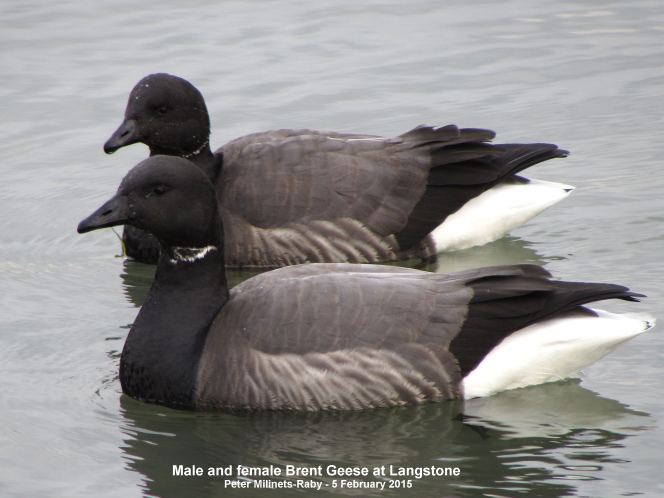
Looking on the
internet the only site I came across that offered a
distinction of tmale and female Brent Geese was
archive.org which said: "The male and female Brent
Goose are similar in appearance, although the male is
usually slightly larger and tends to have a broader
neck patch." . . . http://www.arkive.org/brent-goose/branta-bernicla/
From this my guess is that the nearer goose in Peter's
photo is the male.
For
all news and photos of the Siberian Chiffchaff on
Brook Meadow go to
. . . Siberian
Chiffchaff
Siberian
Chiffchaff
Ralph Hollins
reports that Alan Kitson went to Coldwaltham Sewage
Farm near Pulborough Brooks today and got a photo of a
Siberian Chiffchaff showing very white underparts. See
photo at . . . http://www.sos.org.uk/administrator/components/com_jobline4/logo/p1000830---copy.jpg
Ralph assumed this was a bird acquiring spring plumage
but when he went to find confirmation of that he found
something more interesting.
"What I found was a webpage about 'colour morphing'
suggesting that this species in particular can look
very different depending on its environment. See . . .
https://birdingfrontiers.wordpress.com/2013/02/15/siberian-chiffchaff-ing/
This piece ends with two photos of the same bird in a
Dorset garden - in one the body plumage has the
'normal' slightly brownish tinged underparts, in the
other the underside looks pure white as in Alan
Kitson's photo. Interestingly the Dorset photos were
taken on Feb 5th in 2013 so maybe plumage change to
spring colour has some part in the effect."
For more photos of a
Siberian Chiffchaff go to . . . http://georgeheathpatchbirding.blogspot.co.uk/
WEDNESDAY
FEBRUARY 4 - 2015
Brook
Meadow
Malcolm
Phillips got to the meadow about midday. He saw a
Water Vole by the sluice gate but was in the
wrong place for a photo. Malcolm was on the meadow
side with the hedge in the way so he could not get a
clear shot. He went round to the observation fence and
waited for about half an hour in the hope it would
reappear, but no luck. This was only our second
sighting of 2015 and it was good to know some are
still alive! For more details of the Water Voles of
Brook Meadow go to . . . Water
Voles
Malcolm's best
photo of the day was this lovely Wren surrounded by
Ivy leaves.
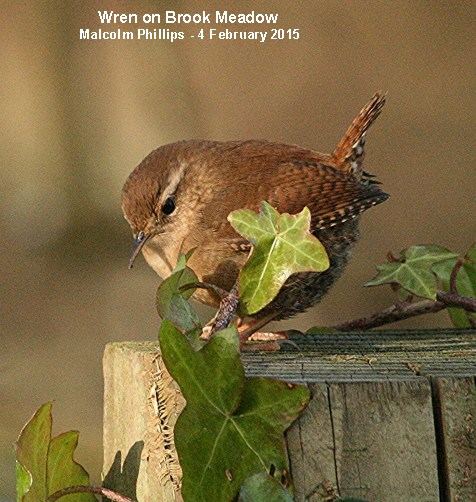
Leigh
Park Gardens
Brian Lawrence
had a walk around Leigh Park Gardens this afternoon.
In the lake he spotted a Water Vole and managed to get
a photo of it swimming. I did not realise they had
Water Voles there.
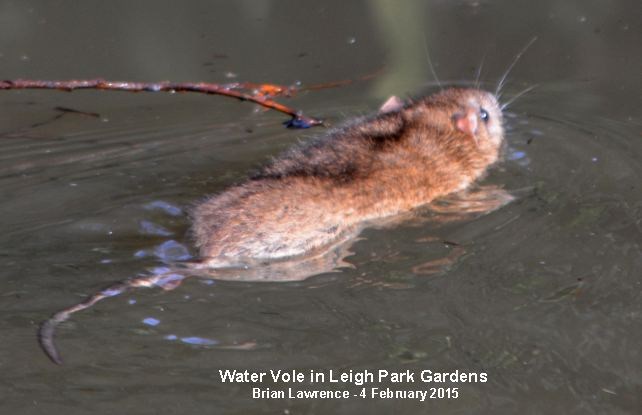
Old Liss Railway
Mike Wells
returned to Old Liss Railway to attempt a better shot
of a Redwing than he managed on his last visit on Feb
2. Patience paid off with this cracking close-up photo
showing well all the main features of this striking
thrush, including the characteristic red flanks, bold
creamy eyebrow and angled moustache. The spots on the
breast are arranged as long dark streaks, quite unlike
those on the Song Thrush, Mistle Thrush or Fieldfare.
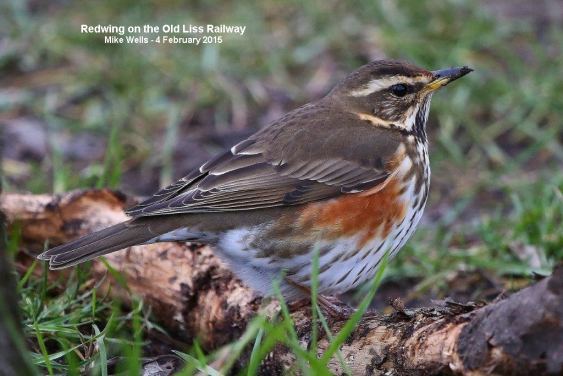
Redwing and Fieldfare
are both winter visitors to this country in huge
numbers, at least one million of each, though most of
them tend to remain up north unless the weather gets
very cold. They breed in the north of Scotland and in
Scandinavia; Fieldfare also breed in Eastern Europe.
Mike also thought he
had got a Mistle Thrush until he inspected his photo
closely which showed arrow-shaped breast spots
characteristic of Song Thrush. The spots on the
breast of the Mistle Thrush are heavier and rounder.
Here is Mike's photo of the Song Thrush at Liss in
comparison with a Mistle Thrush taken by Malcolm
Phillips last year on Hayling Island. When I first
looked at Mike's photo I thought it was a Mistle
Thrush due to its rather severe expression; Song
Thrush usually has a much softer looking face. But the
spots were the give-away.
Mike's
Song Thrush on the left. Malcolm's Mistle Thrush on
the right
Blashford
Lakes
Tony Wootton
had a freezing morning at Blashford but took lots of
photos, mostly of ducks. Here is one I liked of a pair
of Gadwall. These ducks are almost always in pairs. A
bit like Pintail.
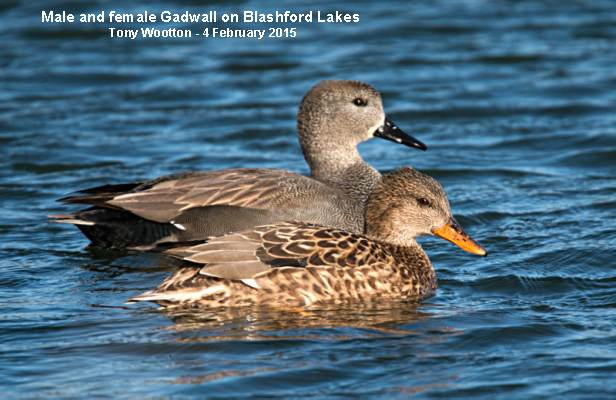
TUESDAY
FEBRUARY 3 - 2015
Gulls
on the ice
I had my usual
constitutional around the town millpond this morning,
well wrapped up as it was very cold, though the early
snow had almost disappeared. The town millpond was
partly frozen with a multitude of gulls standing on
the ice, mostly Black-headed Gulls with a few Common
Gulls and Herring Gulls. The conditions were good for
photography.
This first photo has a Black-headed Gull and Common
Gull close together, showing well the main
differences between the two birds. The Common Gull is
the larger of the two birds with a larger domed head
which is slightly flecked with grey. The bill and legs
are yellow, whereas those of the Black-headed Gull are
bright red.
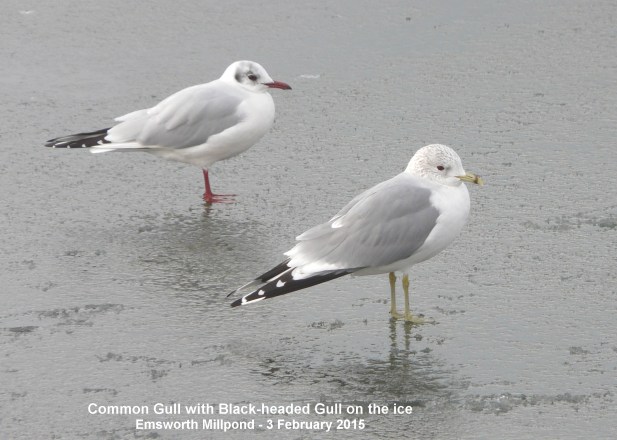
There were also
several juvenile Black-headed Gulls which still
retain some of their brown feathers. Their bills and
legs are also duller red than the adults. I believe
Chris Cockburn said Black-headed Gulls had a good
breeding season in Langstone Harbour, so these birds
could well have come from that colony.
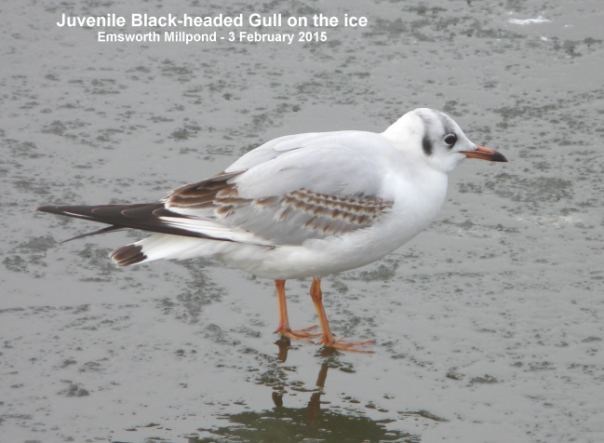
One of the Common
Gulls had distinctly dark head markings. My guess
is that it is a second winter bird just coming into
full maturity. Its white 'wing mirrors' on the end of
the wings are also smaller than one would expect in a
full adult. I would appreciate help with this one.
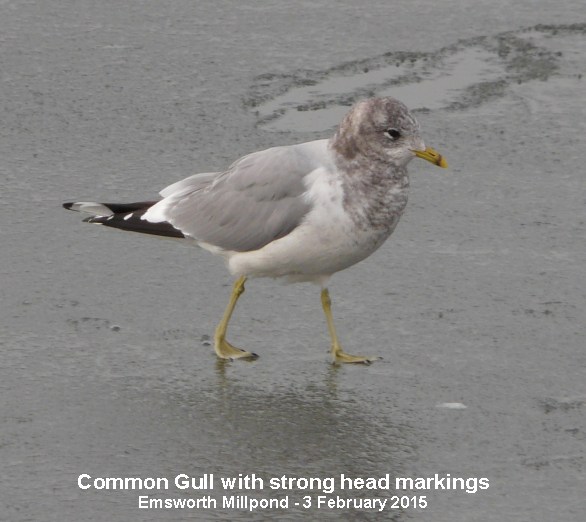
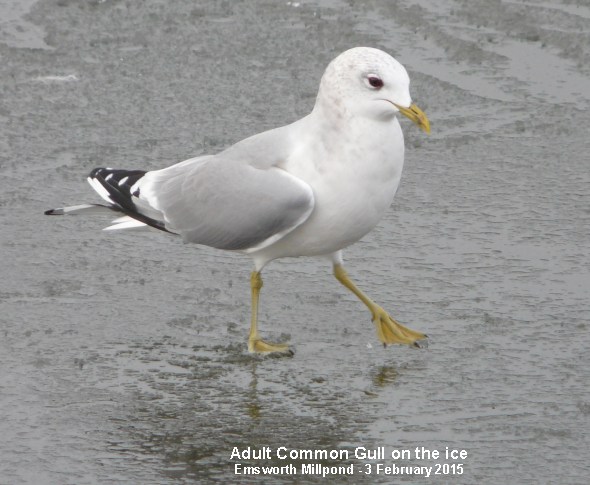
Finally, here is one
of the juvenile Herring Gulls. These birds take
longer to come to maturity than the Black-headed and
Common Gulls.
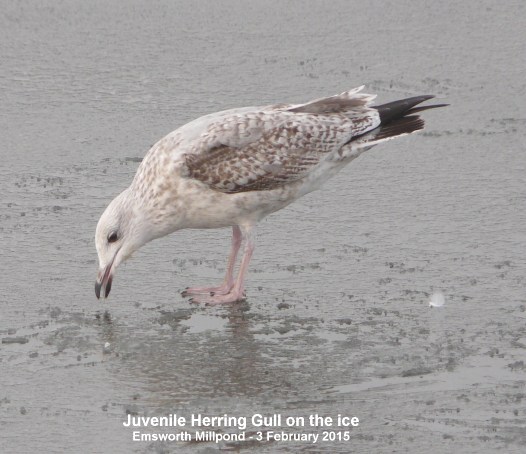
Millpond
Kingfisher
Susan Kelly
has had a couple of splendid Kingfisher experiences on
the town millpond. She writes: "Yesterday, around
9.15, southern end of town millpond (which was mostly
frozen), highish tide, hardly anyone else about. At
first the Kingfisher was sitting on the edge of the
footpath and diving into the sea, then it flew to the
jetty of the sailing club and from there to the
nearest tree overhanging the pond, before spending 5
mins or so fishing inside the structure of the
overflow. Once it had caught a fish it flew back to
the tree, then curved round and began sitting on the
the edge of the path again. I was watching for about
10 mins, sometimes from only a few feet away, before
it was scared off.
And it was there again today, at least I saw it flying
across the pond to the tree which I was on the far
side of the harbour path, around 9.45. Apparently
other people have seen it and taken pictures, so you
may get some sent in. It seems to be worth telling
people to keep an eye out. The important factors seem
to be high tide and no wind, plus reasonable light
(and probably the early morning, with few
passers-by)."
Thanks Susan. I too have seen the millpond Kingfisher
on a couple of occasions over the past week, once
catching a small fish from the pond. Really tame, I
agree.
Langstone
Mill Pond
Peter
Milinets-Raby popped down to the Langstone Mill Pond
in the snow this morning (10am to 11:20am - still no
scope).
Pond (no ice): 17 Teal, Female Wigeon to start with.
The male was feeding on the last bit of salt marsh
behind the mill, until about 10:35am when it flew onto
the pond to join its mate. Cormorant. 2 roosting
Little Egrets. 2 roosting Grey Heron. Nesting Grey
Herons - no movement from the Holm Oak and a standing
bird on the south nest. Water Rail running about along
the edge of the reeds for about 20 minutes.
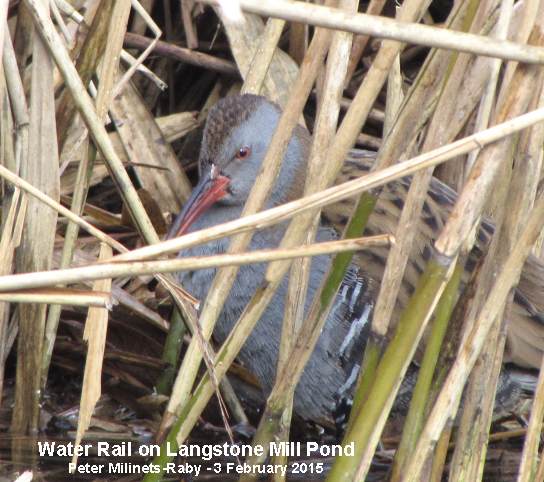
Female Goosander
appeared on the pond from 10:45am - bathed, then sat
on the pipe at the back, before the Cormorant chased
it off, then it slept under the tree overhang behind
the island.
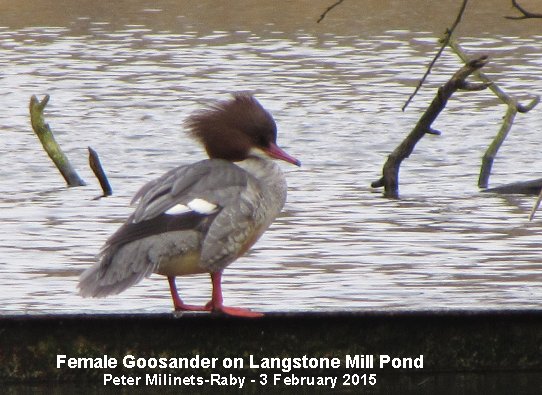
Horse Paddock - frozen
and still covered in snow: 22 Moorhen, 2 female
Pheasant,
Off shore: 25 Teal, 254+ Brent Geese, Female
Goldeneye, 40+ Shelduck.
More
Redwings and Fieldfare
Following Mike
Wells' news of Redwings yesterday, Geoff Gilbert from
Rowlands Castle writes to say this afternoon he saw a
flock of 100+ Fieldfares, mixed with 50 Starlings and
at least 40 Redwings, feeding in the grass beyond the
big oak tree half way along the long meadow, on the
east side of the road, which runs from the railway
bridge, to the north of Finchdean, to the old manor
house now called Old Idsworth Garden - which is just
south of St Hubert's Chapel. Nearer to Old Idsworth
Garden were another 50+ Fieldfare with Starlings and
at least 30 Redwing. Geoff says this is a reliable
spot to find these winter thrushes.
Other
news
Malcolm
Phillips walked up to Westbourne today and got this
fine image of a female Kestrel by Hampshire
Farm.
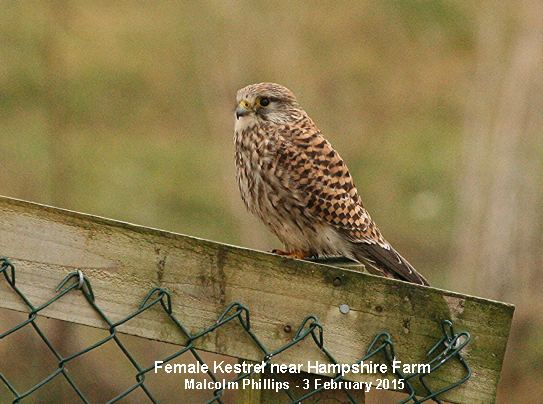
Francis Kinsella was
on Emsworth shore this evening when he captured this
unusual shot of a Lapwing and what looks like a
juvenile Black-tailed Godwit feeding together.
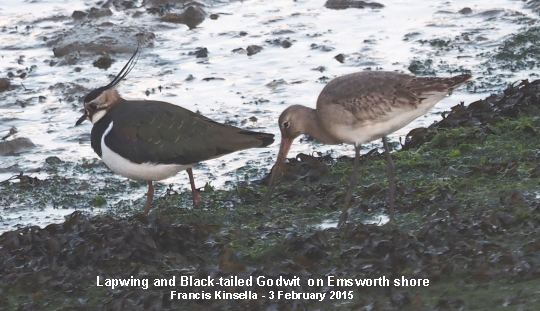
MONDAY
FEBRUARY 2 - 2015
Emsworth
The Mute
Swan family from the Slipper Millpond nest of two
adults and two cygnets is back together again in the
harbour beneath the quay. I really thought the adults
had got rid of the youngsters, but clearly not. They
are together again, but probably not for long.
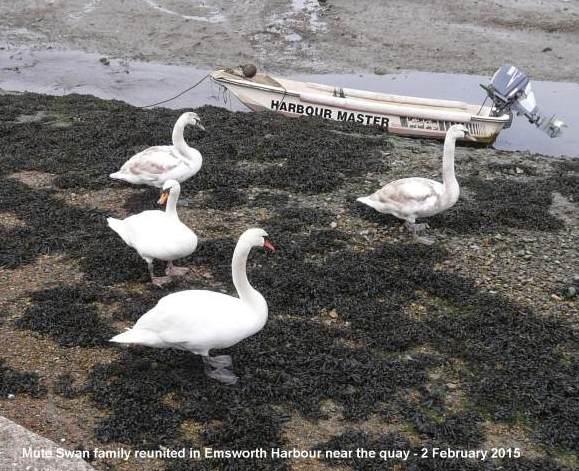
Two Common Redshanks,
two Grey Plovers and a juvenile Black-tailed
Godwit were busy feeding in the low water channel
near the quay. I have seen several juvenile
Black-tailed Godwits feeding in this channel this
winter.
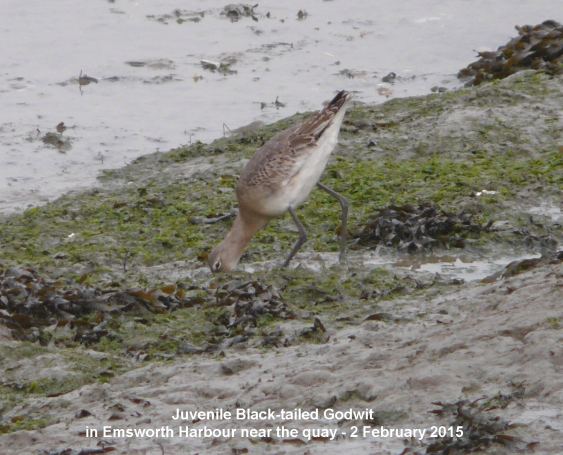
Several Pied
Wagtails were flitting around the edge of the town
millpond as usual late this afternoon. They must roost
somewhere nearby. I had a brief glimpse of a
Kingfisher on the edge of the pond with a small
fish in its bill. Several people have mentioned seeing
a Kingfisher on the millpond recently, so this is
probably a regular. One or two of the Black-headed
Gulls on the town millpond are now getting their
brown hoods. They stand out well from the others which
have just a dark smudge on the sides of their heads.
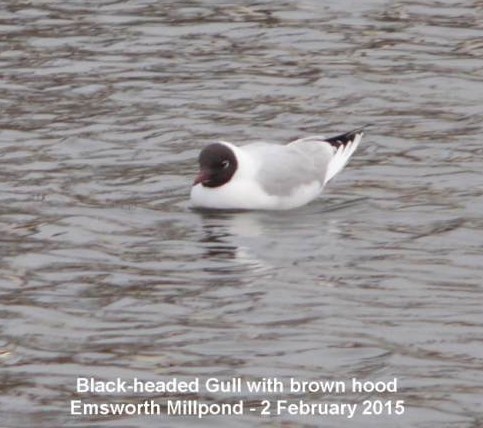
Brook
Meadow
Malcolm
Phillips did not have much to show for his efforts on
Brook Meadow today except for this excellent photo of
a female Chaffinch.
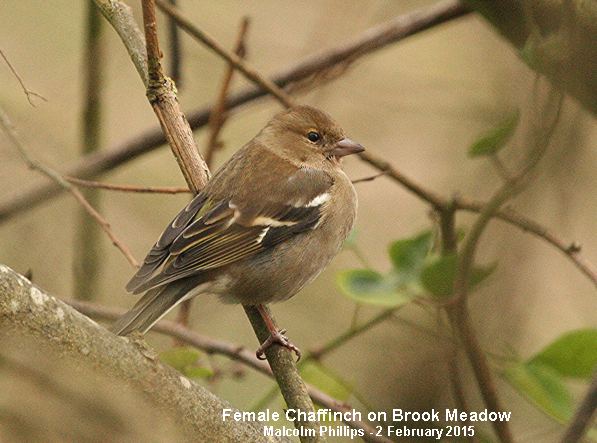
Chaffinches are one of
most common birds on the meadow and in the garden.
Some of the males are now aquiring their breeding
plumage with red face and underparts and are looking
very striking. They could almost be mistaken for a
Bullfinch. In fact, Malcolm did see a Bullfinch by the
south entrance to the meadow, but was too slow to get
a photo. Now, that's just not good enough, Malcolm!
Langstone
Mill Pond
Peter
Milinets-Raby visited Langstone Mill Pond this morning
between 10:04am and 10:48am at high tide. He was
feeling a bit lost without his scope (being
repaired).
On the pond (half frozen over): Wigeon, male &
female, Female Goosander asleep on the tree in the far
corner, 44 Teal, 3 Little Egrets roosting, 4 Grey
Herons roosting , A single Grey Heron standing on the
south nest, no other movement noticed in the Holm Oak,
4 Stock Doves (both paired up).
Frozen horse paddock: 26 Moorhen
Off shore on the high water: 67 Shelduck, 4 Teal, 145+
Brent Geese, 35+ Wigeon, Female Goldeneye, 4 Red
Breasted Merganser.
Redwings
Mike Wells saw
the first local Redwings that I have heard of during
what he described as 'a freezing, muddy stroll along
the Old Liss Railway this morning'. With this cold
weather up north we should be getting more of them
down south and Fieldfares.
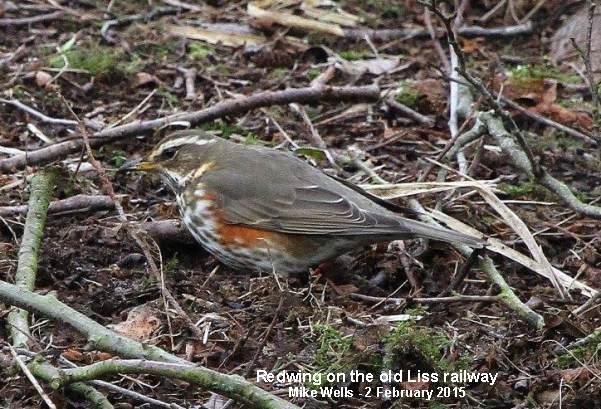
Goldcrest
in flight
Goldcrest is
our smallest bird and hard enough to capture by camera
when still, which it rarely is. But Tony Wootton
managed to get one in flight at Chichester Gravel Pits
this morning. Interesting to see the dark patches on
the bird's wings which I have not noticed before in
the Goldcrest.
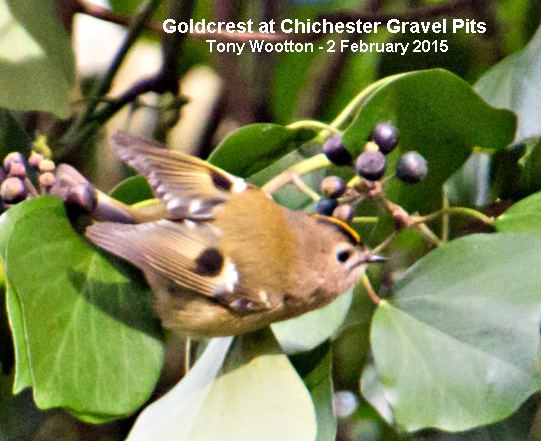
SUNDAY
FEBRUARY 1 - 2015
Brook
Meadow
I went over to
the meadow this morning to take photos of the
conservation work session. The main tasks were
clearing the remains of the wood chippings pile and
the construction of a new dead wood fence at the top
of the river bank near the S-bend, the previous one
having been damaged. Here are members of the group
raking and clearing the wood chippings pile.
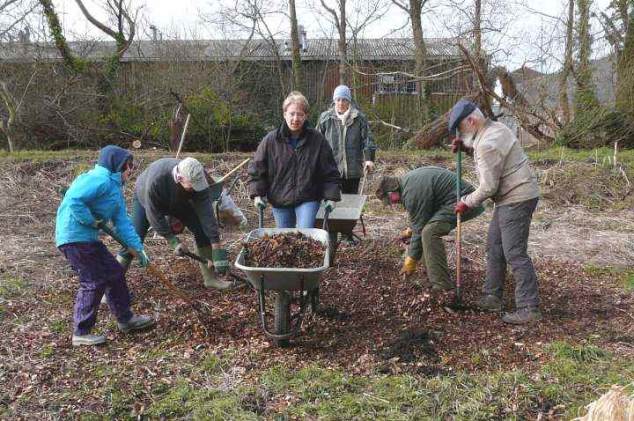
I could only stay for
30 mins, but Malcolm Phillips was present later in the
morning and got a shot of the completed fence after
the end of the work session.
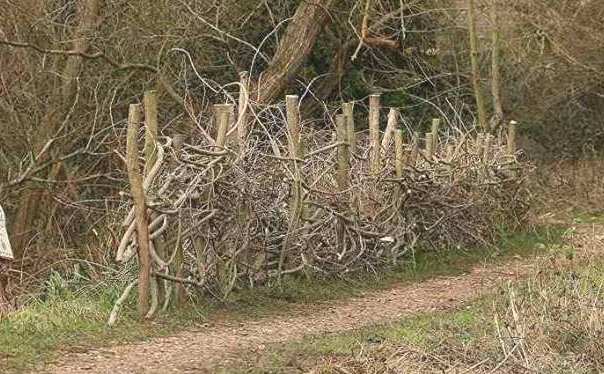
For the full report on
the work session plus more photos go to . . .
http://www.brook-meadow.hampshire.org.uk/bm-diary-2015a.html
While he was on Brook
Meadow, Malcolm also got an excellent photo of a
regular Chiffchaff (not a Siberian) by the
gasholder.
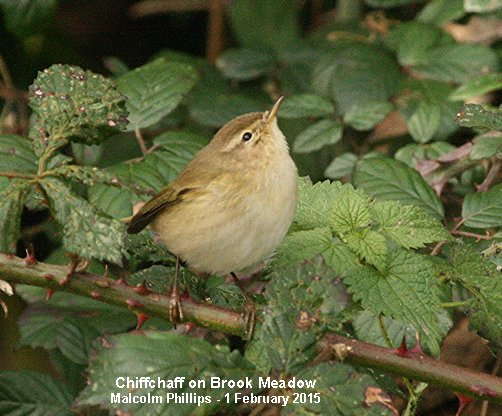
Garden
Chiffchaff
Talking about
Chiffchaffs, we had one in our garden this afternoon,
but only very briefly, hardly giving me time to get
the camera out for a snap though the window. Here it
is, though not a patch on Malcolm's.
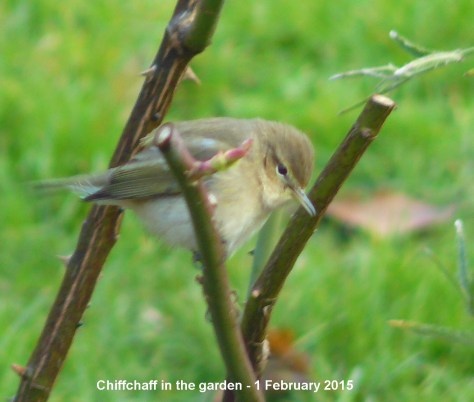
Chiffchaff is a fairly
rare bird in our garden, the last one I saw was in
March 2012. We usually get one or two visits in each
year, mostly in the winter. A few Chiffchaffs do over
winter in this country; most of the population make
their way south to the Mediterranean area.
For
earlier observations go to . . January
16-31